- Hit putovanja S Mondom na sjever Europe Naša preporuka Europska putovanja zrakoplovom Europska putovanja autobusom Daleka putovanja Krstarenja Hrvatska Wellness & vikend aranžmani Skijanje Mediteran
- Sjeverna i Srednja Amerika
- Južna Amerika
- Australija i Južni Pacifik
- Afrika i Bliski Istok
- Sjedinjene Američke Države - SAD
- Dominikanska Republika
- Čile - Patagonija
- Argentina - Patagonija
- Novi Zeland
- Ujedinjeni Arapski Emirati
- Mjanmar - Burma
- Egipat - zemlja faraona
- Južna Afrika
- Zelenortski otoci
- Saudijska arabija
- Prijava / Registracija

Filtriraj putovanja

FIRST MINUTE

Krstarenje Island i Farski otoci

Garantirano
Krstarenje zapadnim Mediteranom luksuznim brodom - Barcelona i Rim
07.07, 04.08
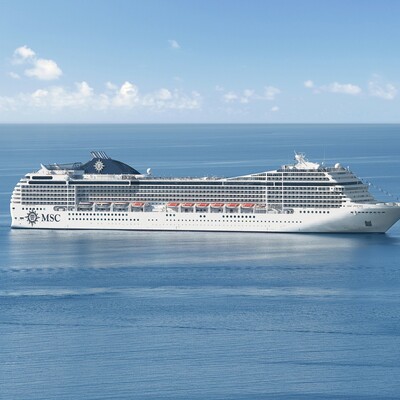
LAST MINUTE
MSC Poesia, krstarenje do Grenlanda - 22 dana
30.06, 30.06, 30.06

MSC Sinfonia, istočni Mediteran - 8 dana, ukrcaj u Splitu i Zadru, sezona 2024.
11.05, 18.05, 01.06, 08.06, 15.06, 22.06, 29.06, 06.07, 13.07, 20.07, 27.07, 03.08, 10.08, 17.08, 24.08, 31.08, 07.09, 14.09, 21.09, 28.09, 05.10, 12.10, 19.10, 26.10, 02.11

Grčka, krstarenje Grčkim otocima i Atena
25.05, 22.06, 06.07, 20.07, 03.08, 17.08, 07.09, 21.09

Grčka, krstarenje Grčkim otocima i Atena, 6.10., 13.10.
06.10, 13.10

POSEBNA PONUDA
MSC Preziosa, krstarenje do Islanda - 12 dana
26.05, 01.07, 24.07

Norveška krstarenje poštanskim brodom
Royal Caribbean, Icon Of The Seas, Karibi - 8 dana, sezona 2024.
17.08, 24.08, 31.08, 07.09, 14.09, 21.09, 28.09, 05.10, 12.10, 19.10, 26.10, 02.11, 09.11, 16.11, 23.11, 30.11, 07.12
ULTRA FIRST MINUTE
GARANTIRANO
{{ trip.title }}
{{ trip.days }}
{{ trip.dates }}
{{ trip.price }}

MSC World Europa, zapadni Mediteran - 8 dana 2024./2025.
05.05, 12.05, 19.05, 26.05, 02.06, 09.06, 16.06, 23.06, 30.06, 07.07, 14.07, 21.07, 28.07, 04.08, 11.08, 18.08, 25.08, 01.09, 08.09, 15.09, 22.09, 29.09, 06.10, 13.10, 20.10, 27.10, 03.11, 10.11, 17.11, 24.11, 01.12, 08.12, 15.12, 22.12, 29.12, 05.01, 12.01, 19.01, 26.01, 02.02, 09.02

MSC Opera, Kanarski otoci - 8 dana, sezona 2024./2025.
03.11, 10.11, 17.11, 24.11, 01.12, 08.12, 15.12, 22.12, 29.12, 05.01, 12.01, 19.01, 26.01, 02.02, 09.02, 16.02, 23.02, 02.03, 09.03

MSC Virtuosa, Norveški fjordovi - 8 dana
11.05, 18.05

Royal Caribbean, Allure Of The Seas, zapadni Mediteran - 8 dana, sezona 2025.
27.04, 04.05, 11.05, 18.05, 25.05, 01.06, 08.06, 15.06, 22.06, 29.06, 06.07, 13.07, 20.07, 27.07, 03.08, 10.08, 17.08, 24.08, 31.08, 07.09, 14.09

Costa Deliziosa - istočni Mediteran - 8 dana
01.06, 08.06, 15.06, 22.06, 29.06, 06.07, 13.07, 20.07, 27.07, 03.08, 10.08, 17.08, 24.08, 31.08, 07.09, 14.09, 21.09, 28.09, 05.10

Costa Smeralda, zapadni Mediteran - 8 dana
10.05, 17.05, 24.05, 31.05, 07.06, 14.06, 21.06, 28.06, 05.07, 12.07, 19.07, 26.07, 02.08, 09.08, 16.08, 23.08, 30.08, 06.09, 13.09, 20.09, 27.09, 04.10, 11.10, 18.10, 25.10, 01.11, 08.11, 15.11, 22.11
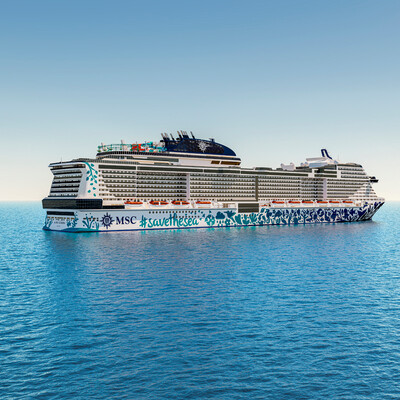
MSC Euribia, Norveški fjordovi - 8 dana
05.05, 12.05, 19.05, 26.05, 09.06, 16.06, 07.07, 14.07, 21.07, 28.07, 18.08, 25.08, 01.09, 08.09, 15.09, 22.09, 29.09, 06.10

MSC Fantasia, zapadni Mediteran - 8 dana 2024.
01.05, 15.05, 22.05, 29.05, 05.06, 12.06, 19.06, 26.06, 03.07, 10.07, 17.07, 24.07, 31.07, 07.08, 14.08, 21.08, 28.08, 04.09, 11.09, 18.09, 25.09, 02.10, 09.10, 16.10, 28.10, 04.11, 11.11, 18.11, 16.12, 23.12, 30.12, 06.01, 13.01, 20.01, 27.01

MSC Grandiosa, zapadni Mediteran - 8 dana
05.05, 12.05, 26.05, 02.06, 16.06, 23.06, 30.06, 07.07, 14.07, 21.07, 28.07, 04.08, 18.08, 25.08, 15.09, 22.09, 29.09, 06.10, 13.10
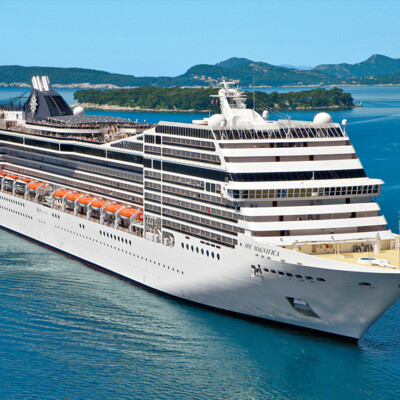
MSC Magnifica, krstarenje oko svijeta - 117 dana - Sezona 2025.
05.01, 05.01, 05.01
od 16.219 €

MSC Orchestra, zapadni Mediteran - 11 dana 2024.
04.05, 14.05, 24.05, 03.06, 13.06, 23.06, 03.07, 13.07, 23.07, 02.08, 12.08, 22.08, 01.09, 11.09, 21.09, 01.10, 11.10, 21.10, 31.10

MSC Seaview - Italija, Španjolska, Francuska - 8 dana - 2024.
06.05, 13.05, 20.05, 27.05, 03.06, 10.06, 17.06, 24.06, 01.07, 08.07, 15.07, 22.07, 29.07, 05.08, 12.08, 19.08, 26.08, 02.09, 09.09, 16.09, 23.09, 30.09, 07.10, 14.10
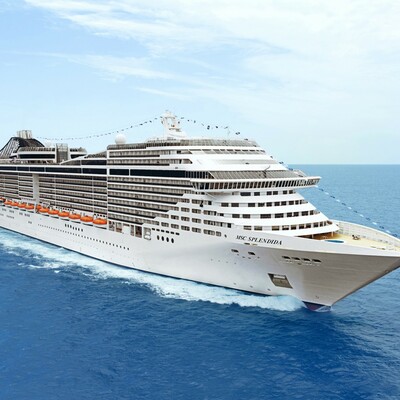
MSC Splendida, istočni Mediteran, Grčka, Turska - 10 dana - 2024.
30.05, 08.06, 17.06, 26.06, 05.07, 14.07, 23.07, 01.08, 10.08, 19.08, 28.08, 06.09, 15.09, 24.09, 03.10, 12.10, 21.10

MSC Virtuosa, Madeira, Kanari, Lisabon - 13 dana

MSC Seaside, zapadni Mediteran - 8 dana
22.06, 29.06, 06.07, 13.07, 20.07, 27.07, 03.08, 10.08, 17.08, 24.08, 31.08, 07.09, 14.09, 21.09, 28.09, 05.10, 12.10, 19.10

Brod Avantura, Krstarenje Jadranom, Split-Dubrovnik (one way), 19.5., Akcija od 640 eur
Costa deliziosa, krstarenje oko svijeta - 128 dana, sezona 2025./2026..
21.11, 21.11, 21.11, 21.11
od 15.319 €

Costa Deliziosa, krstarenje oko svijeta - 131 dan - sezona 2024.
07.12, 07.12, 07.12, 07.12
od 14.819 €
Costa Deliziosa, od Singapura do Venecije - 33 dana

Costa Diadema - Krstarenje Danska, Norveška, Njemačka
25.05, 01.06, 15.06, 22.06
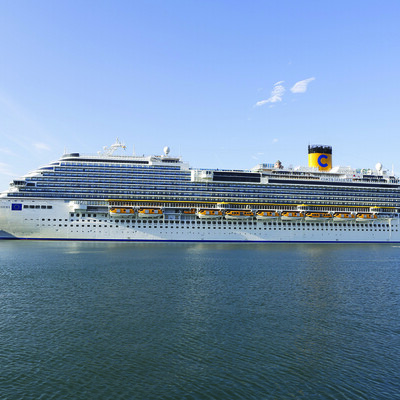
Costa Diadema - Krstarenje Norveškim fjordovima, grupno
Costa diadema, kanarski otoci - 15 dana.
06.10, 20.10, 03.11
Costa Diadema, Španjolska i Portugal - 15 dana

Costa Fascinosa - Malta, Mykonos, Kreta, Zakhynthos - 8 dana

Costa Fascinosa, zapadni Mediteran - 11 dana
Costa fascinosa, zapadni mediteran - 15 dana.
02.05, 16.05

Costa Favolosa, Island i Grenland - 23 dana
07.07, 07.07, 07.07

Costa Favolosa, Island, Škotska i Shetlandski otoci - 15 dana
11.08, 11.08, 11.08
Costa Favolosa, krstarenje do Škotske - 9 dana
Costa favolosa, lofotski otoci i nordkapp - 15 dana.
25.05, 25.05, 25.05

Costa Fortuna - Italija, Turska, Grčka, Španjolska, Francuska

Costa Fortuna, krstarenje iz Istanbula - 8 dana
16.06, 23.06, 30.06, 07.07, 14.07, 21.07, 28.07, 04.08, 11.08, 18.08, 25.08, 01.09, 08.09
Costa Fortuna, Mediteran - 15 dana

Costa Pacifica, zapadni Mediteran - 8 dana
12.05, 19.05, 26.05, 02.06, 09.06, 30.06, 07.07, 14.07, 21.07, 28.07, 04.08, 11.08, 18.08, 25.08, 01.09, 08.09, 15.09, 22.09, 29.09, 06.10, 13.10, 20.10, 27.10

Costa Toscana, zapadni Mediteran - 8 dana 2024./2025.
04.05, 11.05, 18.05, 25.05, 01.06, 08.06, 15.06, 22.06, 29.06, 06.07, 13.07, 20.07, 27.07, 03.08, 10.08, 17.08, 24.08, 31.08, 07.09, 14.09, 21.09, 28.09, 05.10, 12.10, 19.10, 26.10, 02.11, 09.11, 16.11, 23.11, 30.11, 07.12, 14.12, 21.12, 28.12, 04.01, 11.01, 18.01, 25.01, 01.02, 08.02, 15.02, 22.02
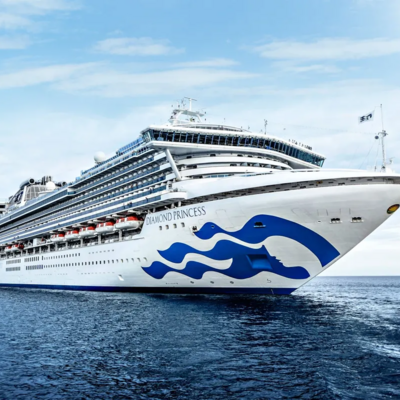
Diamond Princess, Grupno premium krstarenje Japanom i Južnom Korejom

Discovery Princess, obala Kalifornije - 8 dana
05.10, 19.10, 02.11
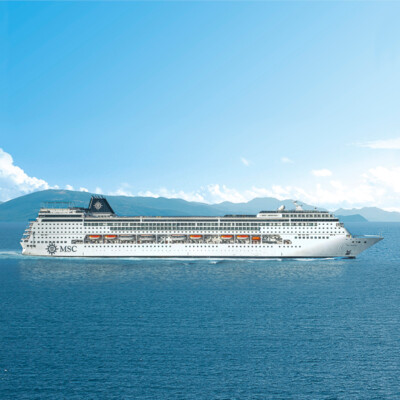
MSC Armonia, istočni Mediteran - 8 dana
06.05, 13.05, 20.05, 27.05, 03.06, 10.06, 17.06, 24.06, 01.07, 08.07, 15.07, 22.07, 29.07, 05.08, 12.08, 19.08, 26.08, 02.09, 09.09, 16.09, 23.09, 30.09, 07.10, 14.10, 21.10, 28.10

MSC Divina, istočni Mediteran - 8 dana
24.05, 31.05, 07.06, 14.06, 21.06, 28.06, 05.07, 12.07, 19.07, 26.07, 02.08, 09.08, 16.08, 23.08, 30.08

MSC Euribia, Grupno krstarenje Norveškim fjordovima
Msc euribia, zapadna europa - 8 dana.

MSC Lirica, istočni Mediteran - 8 dana
04.05, 11.05, 18.05, 25.05, 01.06, 08.06, 15.06, 22.06, 29.06, 06.07, 13.07, 20.07, 27.07, 03.08, 10.08, 17.08, 24.08, 31.08, 07.09, 14.09, 21.09, 28.09, 05.10, 12.10, 19.10

MSC Lirica, krstarenje do Egipta - 12 dana
26.10, 06.11

MSC Lirica, krstarenje istočnim Mediteranom, grupno
Msc magnifica, krstarenje oko svijeta - 119 dana, sezona 2026..
od 16.119 €

MSC Meraviglia, SAD i Kanada - 8 dana
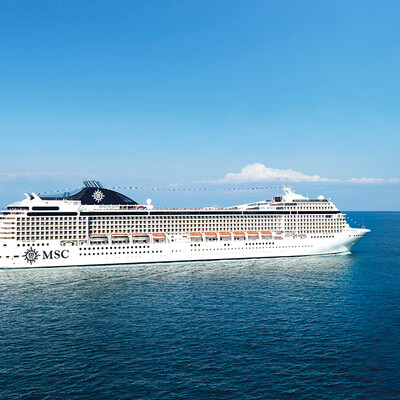
MSC Musica, zapadni Mediteran - 8 dana
14.05, 21.05, 28.05, 04.06, 18.06, 25.06, 02.07, 09.07, 16.07, 23.07, 30.07, 06.08, 13.08, 20.08, 27.08, 03.09, 10.09, 17.09, 24.09, 01.10, 08.10, 15.10

MSC Poesia, Baltik - 11 dana

MSC Poesia, Baltik - 8 dana
08.06, 22.06, 27.07, 10.08
MSC Poesia, Norveški fjordovi i Baltik - 15 dana
01.06, 08.06, 15.06
MSC Poesia, zapadni Mediteran - 12 dana
11.10, 22.10, 02.11
MSC Preziosa - Grupno krstarenje do Islanda
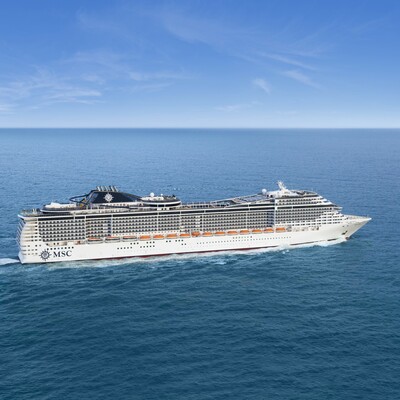
MSC Preziosa, krstarenje do Nordkapa - 12 dana
15.05, 06.06, 18.08
MSC Preziosa, krstarenje do Svalbarda - 15 dana
17.06, 04.08

MSC Seascape, Karibi - 8 dana, sezona 2024.
25.05, 01.06, 08.06, 15.06, 22.06, 29.06, 06.07, 13.07, 20.07, 27.07, 03.08, 10.08, 17.08, 24.08, 31.08, 07.09, 14.09, 21.09, 28.09, 05.10, 12.10, 19.10, 26.10

MSC Seashore, Karibi - 8 dana, sezona 2024./2025.
05.05, 12.05, 19.05, 26.05, 09.06, 23.06, 07.07, 21.07, 04.08, 18.08, 01.09, 15.09, 29.09, 13.10, 27.10, 10.11, 24.11, 08.12, 22.12, 05.01, 19.01, 02.02, 02.03, 30.03

MSC World America, Karibi - 8 dana, sezona 2025.
12.04, 19.04, 26.04, 03.05, 10.05, 17.05, 24.05, 31.05, 07.06, 14.06, 21.06, 28.06

MSC World Europa - Grupno krstarenje zapadnim Mediteranom

Royal Caribbean, Oasis of the Seas, zapadni Mediteran - 8 dana
23.05, 30.05, 06.06, 20.06, 27.06, 04.07, 11.07
Po zemljama.
Vrijeme je za putovanje!
Pretražite našu ponudu
Pretražite kroz ključne riječi
...i dalje niste odlučili? Kontaktirajte nas, da zajedno nađemo Vaše putovanje

Između nebeskog plavetnila i beskrajnih horizonta, krstarenje predstavlja prefinjeni ples putovanja i luksuza na talasima okeana. Svako krstarenje je priča za sebe, putovanje koje se rađa iz snova i otkriva neistražene svetove na načine koje kopno ne može da dostigne.
Sunce se miluje s horizontom dok se brod polako uplovljava u luku, spremajući se da otkrije svoje tajne putnicima koji su došli da istraže. Kristalno plave vode često postaju pozornica za nezaboravne trenutke – zalaske sunca koji se ogledaju na površini mora, igru delfina u pramcu broda i dubinska čuda podvodnog sveta.
Krstarenja nisu samo putovanja, već i prozor u različite kulture, ukuse i tradicije. Svaka luka donosi novu avanturu, sa mirisima egzotične hrane, tkaninama svetlih boja i zvucima lokalne muzike koji se stapaju u jedinstvenu simfoniju. Uplovljavanje u nove gradove pruža putnicima priliku da uživaju u raznolikosti sveta, istražujući istorijske spomenike, skrivene uličice i prelepe pejzaže.
Luksuzni brodovi postaju plutajući svetovi sami za sebe. Gosti uživaju u besprekornim uslugama, udobnosti prostranih kabina i raznovrsnosti zabavnih aktivnosti. Od restorana sa vrhunskom kuhinjom do wellness centara i pozorišta na brodu, svaki trenutak postaje prilika za uživanje i opuštanje.
Krstarenja su i odmor i avantura u jednom. Mogućnost istraživanja udaljenih destinacija kombinuje se sa udobnošću i raskoši putovanja. Plovidba prema horizontu pruža osećaj slobode i tišine koji se retko može pronaći drugde. To je prilika da se oseti snaga prirode, ali i da se uživa u bezbrižnom luksuzu.
Dok se sunce spušta i boje neba prelaze u nijanse crvene i narandžaste, putnici se osvrću na dan ispunjen novim doživljajima i pripremaju se za noć punu čarobnih trenutaka. Krstarenje je više od putovanja; to je putovanje duše, uplovljavanje u nepoznato sa otvorenim srcem i spremnošću da se stvori priča koja će trajati zauvek.
Postanite deo naše zajednice
Budite obavešteni o najnovijim akcijama i ponudama za najbolja putovanja. Dobrodošli u svet nezaboravnih putovanja i vrhunskog provoda.

- ✅ Online bukirati željeni aranžman
- ✅ Odmah proveriti raspoloživost kapaciteta i videti cene
Na sajtu možete:
- ✅ Platiti online
- ✅ Sistem Vam automatski šalje fiskalni račun i Ugovor
- ✅ Sistem Vam automatski šalje informacije za preostali dug i instrukcije za plaćanje
- ❌ Dolazak u agenciju
- ❌ Odlazak u banku
OBAVIJEST – RADNO VRIJEME TIJEKOM USKRŠNJIH BLAGDANA
Dana 29.03. na Veliki petak naša poslovnica na adresi Trg bana Josipa Jelačića 4, Zagreb će raditi skraćeno u terminu 08:00h-13:00h! U subotu 30.03. poslovnica radi u redovnom vremenu 09:00h-13:00h. Na Uskršnji ponedjeljak 01.04. poslovnica će biti zatvorena.
Krstarenja Mediteranom
Krstarenja mediteranom - msc i costa krstarenja. kvalitetne ponude za krstarenje istočnim i zapadnim mediteranom s renomiranim kompanijama., naša preporuka.

Krstarenje Jadranom na drvenom jedrenjaku "Moja Maja"

Krstarenje MSC Sinfonia | Hrvatska, Italija, Grčka | Istočni Mediteran | Polasci iz Splita i Zadra | 8 dana

Krstarenje MSC Armonia | Krstarenje do grčkih otoka | Istočni Mediteran | Polasci iz Venecije | 8 dana

Krstarenje MSC Splendida | Italija, Grčka, Turska | Istočni Mediteran | Polasci iz Trsta | 10 dana

Krstarenje MSC World Europe | Italija, Malta, Španjolska, Francuska | Zapadni Mediteran | Polasci iz Genove | 8 dana

Krstarenje MSC Orchestra | Krstarenje do Portugala, Baleara i Sardinije | Zapadni Mediteran | Polasci iz Genove | 11 dana

Krstarenje MSC Euribia | Norveški Fjordovi | Krstarenje sjeverom Europe | Polasci iz Kopenhagena i Kijeva | 8 dana

Krstarenje MSC Poesia | Krstarenje sjeverom Europe | Polasci iz Kopenhagena | 8 dana

Krstarenje MSC Poesia | Krstarenje do Grenlanda | Polasci iz Kopenhagena | 22 dana

Krstarenje MSC Lirica | Krstarenje do otoka Mikonos i Santorini | Istočni Mediteran | Polasci iz Venecije | 8 dana

Krstarenje MSC Lirica | Svjetska čuda antičkog svijeta | Istočni Mediteran | Polasci iz Venecije | 12 dana
Krstarenja Mediteranom – MSC i Costa krstarenja. Nigdje na svijetu ne postoji tolika koncentracija povijesnih lokaliteta, prirodnih i kulturoloških zanimljivosti kao na Mediteranu. Krstarenja Mediteranom podijeljena su u dvije kategorije – krstarenja istočnim Mediteranom i krstarenja zapadnim Mediteranom. Unutar svake od navedenih kategorija postoji više itinerera jer je kulturološko bogatstvo Mediterana preveliko i prebogato da bi ga se moglo obuhvatiti jednim krstarenjem. Svaka ruta ima doista vrhunske destinacije, a velika prednost krstarenja je što u tjedan dana možete posjetiti nekoliko zemalja s ciljanim posjetom nazanimljivijim lokalitetima. Iz naše ponude izdvajamo: krstarenje zapadnim Mediteranom – MSC Divina i MSC Fantasia različiti itinereri uz prihvatljive cijene. Iz ponude za istočni Mediteran izdvajamo krstarenje MSC Musica s polaskom iz Venecije i krstarenjem uz obalu Jadrana. Povratak uz obalu Grčke s posjetom najvažnijim lokalitetima kao što su Santorini, Mykonos i Olimpija. Provjerite naše ponude, kontaktirajte nas za raspoloživost i dodatne informacije. Obratite se s povjerenjem – Azur Tours
Koristimo kolačiće (eng. „cookies“) za pružanje boljeg korisničkog iskustva. Nastavkom pregleda web-stranice slažete se s policom privatnosti .
Svijet Krstarenja
Msc cruises.
Kompanija MSC Crociere vas poziva da otkrijete užitke ekskluzivnih krstarenja uz najbolju talijansku tradiciju. Uspjeh i omiljenost kompanije MSC kreiraju ljudi. Visoko kvalificirano osoblje uvijek je ljubazno i spremno pomoći. Na brodovima MSC nikad se nećete osjećati usamljeno. Brojno osoblje na brodovima MSC je pažljivo izabrano, čine ga pravi timski igrači koji su spremni udovoljiti svakoj Vašoj želji.
Više o brodaru
Šarm, profesionalnost i elegancija odlike su svakog kapetana i brodskog osoblja koji o Vama brinu od početka do kraja Vašeg krstarenja. Iskusnim kapetanima na brodovima MSC flote, sigurnost i briga o putnicima te posadi na prvom je mjestu.
Svi članovi MSC posade svojim iskustvom i spremnošću da ispune svaku Vašu želju zasigurno će pridobiti Vaše povjerenje. Odabrani su najbolji iz različitih područja turizma. Isto tako svi članovi posade koji će Vam biti na usluzi tijekom krstarenja govore strane jezike kao što su talijanski, engleski, francuski, njemački i španjolski.
Kontinuirana edukacija i treninzi koje pohađaju članovi MSC posade u kombinaciji sa poznatom talijanskom gostoljubivosti garantiraju profesionalnu i kvalitetnu uslugu.
Krstarenja MSC također su poznata po izvrsnoj hrani na brodovima. Vrhunski kuhari i konobari pripremit će i poslužiti Vas tisućama vrhunskih jela i tako probuditi Vaša nepca. Očarat će Vas ne samo talijanskom kuhinjom već i vrhunski pripremljenom međunarodnom paletom jela ovisno od krajeva kroz koje putujete. Tako lokalne specijalitete možete okusiti i na samom brodu bilo da se radi o doručku, ručku ili spektakularnoj večeri na otvorenom.
Okruženje u kojem provodite velik dio Vaših praznika izuzetno je važno. Zato su MSC brodovi brižno osmišljeni. Profinjen stil uređenja uz ukusno oblikovane prostorije i odabir boja čine doživljaj plovidbe na ovom putujućem hotelu više nego ugodnim. Krstarenje brodovima MSC uz brojne detalje i opušteno okruženje učinit će Vaše putovanje nezaboravnim. Što je ljepše od putovanja s kojeg ćete se vratiti odmorni i puni energije!? Krstarenje uz MSC Vam omogućuje upravo to. Brodovi opremljeni suvremenim wellness centrima, salonima za masažu, saunama i bazenima omogućit će opuštanje i regeneraciju tijela i duha. Želite li aktivni odmor MSC je također Vaš izbor. Želite li se nakon odmora zabaviti posjetite diskoteku i zaplešite do dugo u noć, uživajte u spektakularnim kazališnim predstavama, iskusite sreću u kockarnici ili popijte Vaše omiljeno piće u nekim od brodskih barova i salona.
Krstarenja su idealan način putovanja u krugu obitelji. Djeca će biti oduševljena jer za njihovu zabavu brine cijela grupa animatora. Tako im je igra i zabava dostupna cijeli dan a uz bogati program prilagođen upravo njima zasigurno im neće biti dosadno. Brodski Mini Club okuplja djecu svih dobi. Od sportskih natjecanja do igara u bazenu, ukusnih zalogaja i traženja blaga…Vaši najmlađi bezbrižno će se zabavljati. Dok se djeca zabavljaju i proživljavaju najbolje praznike u svom životu, opustite se i uzmite neko vrijeme samo za sebe.
Krstarenja su također idealan način putovanja za mlade bračne parove. Na Vašem bračnom putovanju pobrinut će se o svakom detalju i učiniti Vaše krstarenje jedinstvenim i nezaboravnim iskustvom. Romantična večera uz svijeće, doručak u krevetu i beskrajni trenuci posvećeni samo Vama pridonijet će da Vaše putovanje protekne u bajkovitom ozračju. Tijekom krstarenja pružaju se brojne mogućnosti za opuštanje, zabavu i sklapanje novih prijateljstava. Dani ispunjeni rekreacijom, opuštanjem i uzbudljivim trenucima ili pak romantične i plesne noći sastavni su dio Vašeg bračnog putovanja koje će Vam zauvijek ostati u sjećanju.
U poslovnom svijetu ništa nije prepušteno slučaju. U MSC-u su svjesni važnosti svakog detalja i zato Vam svojim iskustvom, stilom i apsolutnom točnošću pružaju kvalitetu kakvu želite. Nakon završnog sastanka ili konferencije na brodu uvjerit ćete se koliko ste pridonijeli ugledu Vašeg poduzeća jer će Vaši uzvanici i gosti biti oduševljeni doživljajima na krstarenju. Krstarenje omogućuje odličan omjer poslovnog i opuštenog putovanja. Jedinstvenu atmosferu koju je moguće doživjeti samo na brodu, dopunit će vrhunsko opremljeni konferencijski centri koji će održavanje Vaših sastanaka učiniti izuzetno elegantnim i „sa stilom“.
KATALOZI KRSTARENJA ZA 2020./2021. GODINU:
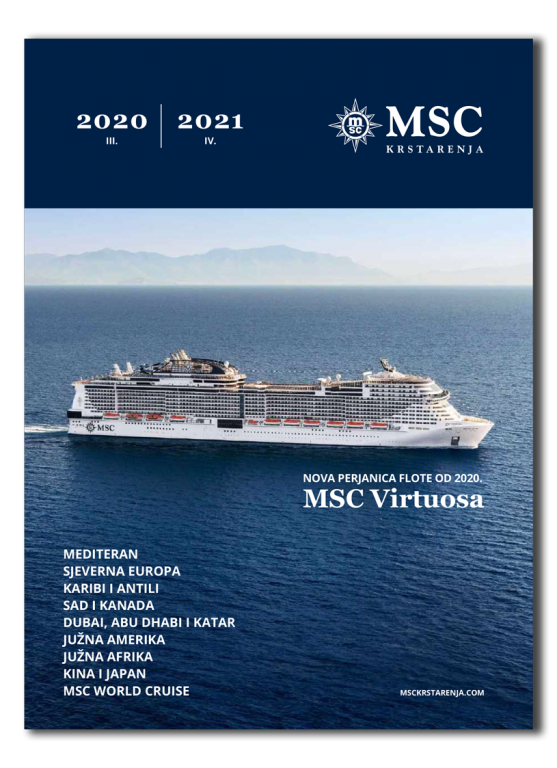
Pogledajte PDF datoteku (34,2 MB) >>>
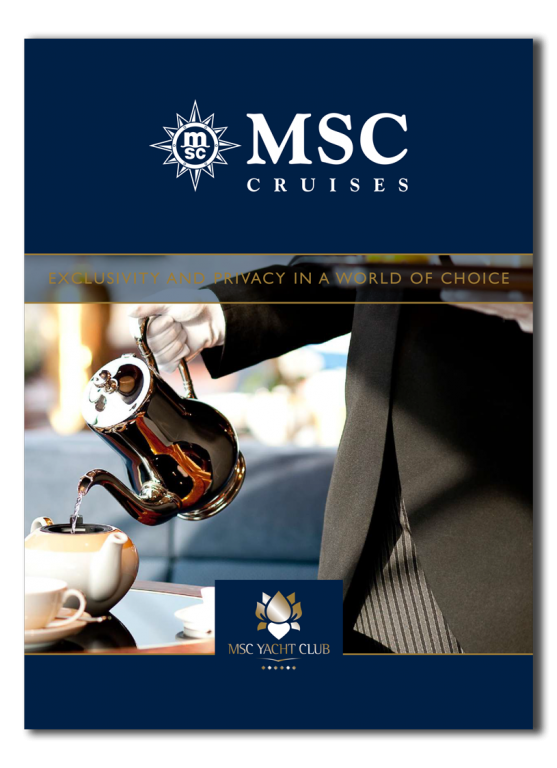
Pogledajte PDF datoteku (2,2 MB) >>>

MSC EURIBIA

MSC SEASCAPE

MSC WORLD EUROPA

MSC SEASHORE
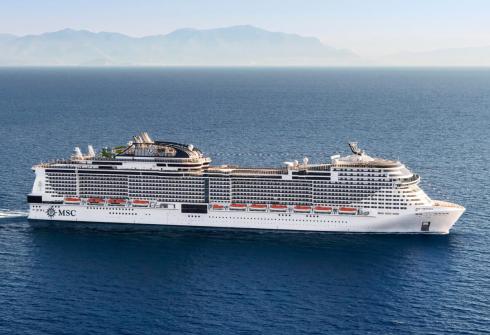
MSC VIRTUOSA
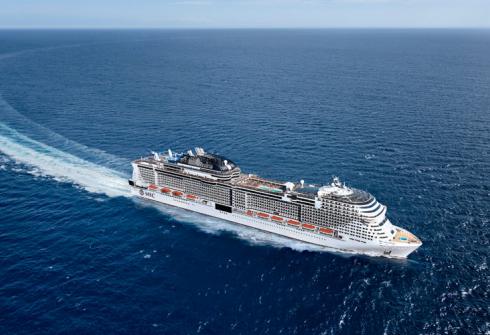
MSC GRANDIOSA
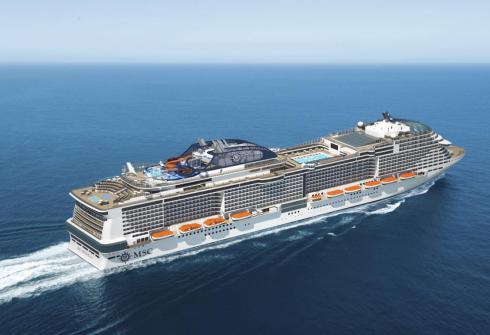
MSC BELLISSIMA

MSC SEAVIEW

MSC SEASIDE
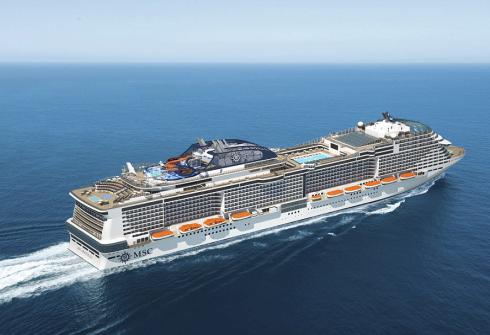
MSC MERAVIGLIA
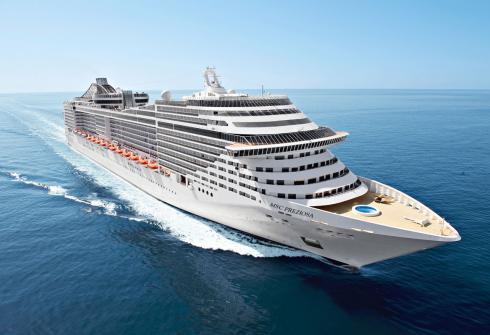
MSC PREZIOSA
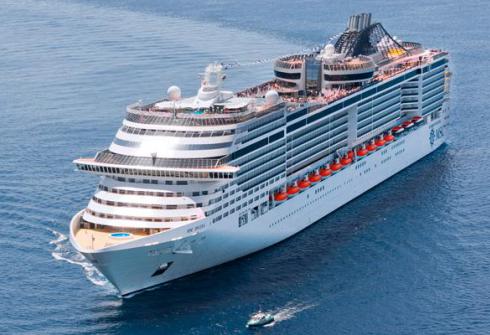
MSC MAGNIFICA

MSC SPLENDIDA

MSC FANTASIA
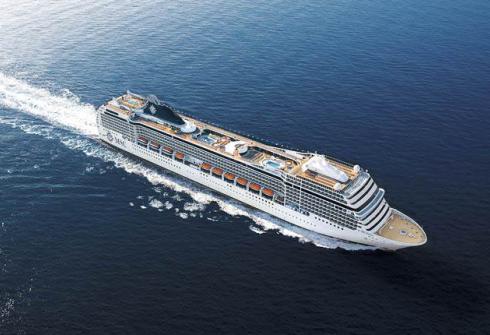
MSC ORCHESTRA
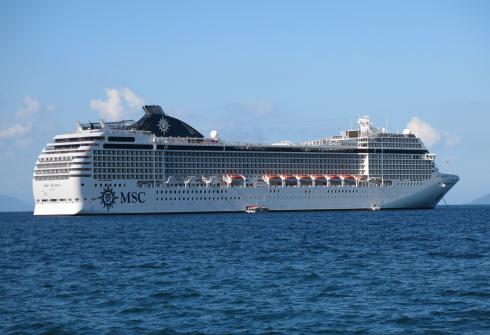
MSC SINFONIA
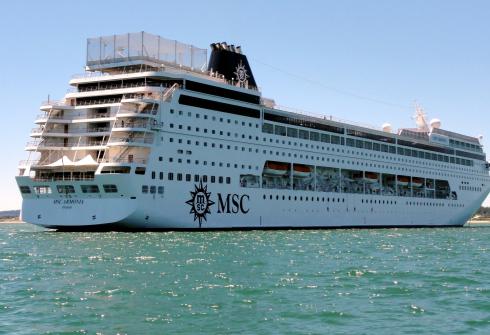
MSC ARMONIA

MSC MSC WORLD AMERICA
Ova internetska stranica koristi kolačiće za pružanje boljeg korisničkog iskustva. Korištenjem naših stranica slažete se s korištenjem kolačića. Za vlastite potrebe analitike koristimo Google Analytics, koji namjesti kolačiće. Više o kolačićima .


KRSTARENJA 2024
SEZONA 2024
KRSTARENJA ZA CEO SVET
SPECIJALIZOVANA AGENCIJA ZA KRSTARENJA
Kontaktirajte nas za savet pri izboru krstarenja, u nastavku pogledajte ponude…
VELIKI POPUSTI NA GRUPNA KRSTARNJA MEDITERANOM I KARIBIMA
PAKET ARANŽMANI SA VODIČEM 2024:
RANI BUKING sezona 2024/2025 Individualno:
Zaplovite i vi i doživite svet na drugačiji način!

Dobro došli u svet krstarenja!
U mogućnosti smo da Vam ponudimo nezaboravna krstarenja za ceo svet sa grupnim polascima iz Beograda i Novog Sada!
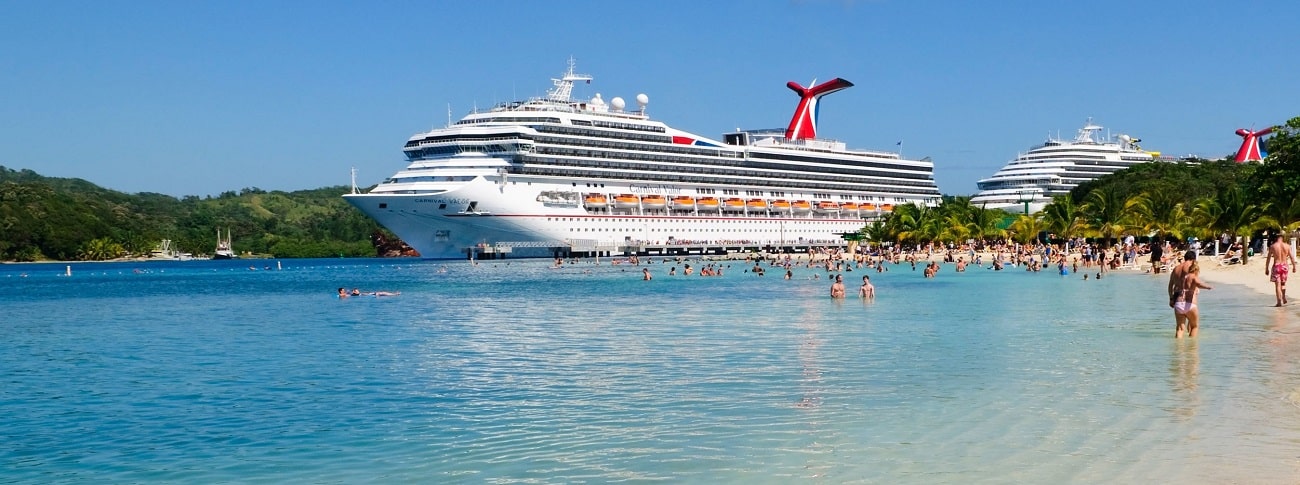
Krstarenje pruža niz opcija koje možete izabrati, uključujući krstarenje u ekspedicijama (arktik, antartika, potraga za polarnom svetlošću…), krstarenje rekama i krstarenje okeanima, kao i različite stilove i veličine brodova od manjih, intimnijih brodova do mega brodova kao što je Roial Caribbean’s Allure of the Seas and Oasis of the Seas.
Jednostavnost krstarenja: Krstarenje mnogo olakšava putnicima koji više vole da imaju najveći deo odmora u jednom itineraru i ceni. U zavisnosti od toga gde plovite, ponekad to znači da krenete na brod iz svoje najbliže luke, što ga čini savršenim za one koji vole da putuju. Kada je krstarenje rezervisano, putnici mogu da se odmaraju znajući da se više ne moraju upućivati pozive, osim da odluče koji izlet da izaberu.
Vrednost: Krstarenja su se pokazala kao jedan od najekonomičnijih načina za odmor. Mnogi putnici vole ideju da znaju koliko će većina njihovih odmora koštati jer krstarenja obično uključuju obroke, zabavu, smeštaj i ponekad bonuse na brodu. Izbor stilova kabine, bez pogleda, unutarnjih kabina do vanjskih kabina s balkonom ili lux suite kabina, osigurava da za svakoga postoji izbor.
Zabava na putničkim brodovima: Nikada vam neće biti dosadno na brodu. Opšte je poznato i sada se očekuje da će zabava na brodu biti najbolja. Brodske kompanije nude noćnu zabavu, uključujući bendove pored bazena, pozorište i koncerte u večernjim časovima, diskoteke, show programe, komedije i muzičke revije, a većina većih brodova ima više opcija za ručavanje i kasino na brodu. Raznolikost i kvalitet zabave na brodu, koju nude brodovi za krstarenje, svakako doprinosi vrednosti koju nudi i zbog čega mnogi ljudi postaju strastveni kruzeri.
Posetite više destinacija prilikom krstarenja Mogućnost obilaska ne samo jedne, već više luka i zemalja tokom krstarenja čini idealan odmor za mnoge ljude. Nijedno drugo putovanje ne nudi putniku ovoliko destinacija i pogodnost da se samo jednom raspakuje. Brod postaje vaš način prevoza bez potrebe za unajmljivanjem automobila i navigacijom kroz strane zemlje. Krstarenje je savršeno rešenje za odmor…!
Porast popularnosti i dostupnosti krstarenja povećava interesovanje i naših putnika za polaske na sve svetske kruzeve, od nama najbližeg Mediterana preko norverških fjordova do Kariba i Novog Zelanda….
MSC CRUISES INDIVIDUALNA KRSTARENJA 2022/2023 U PRODAJI!
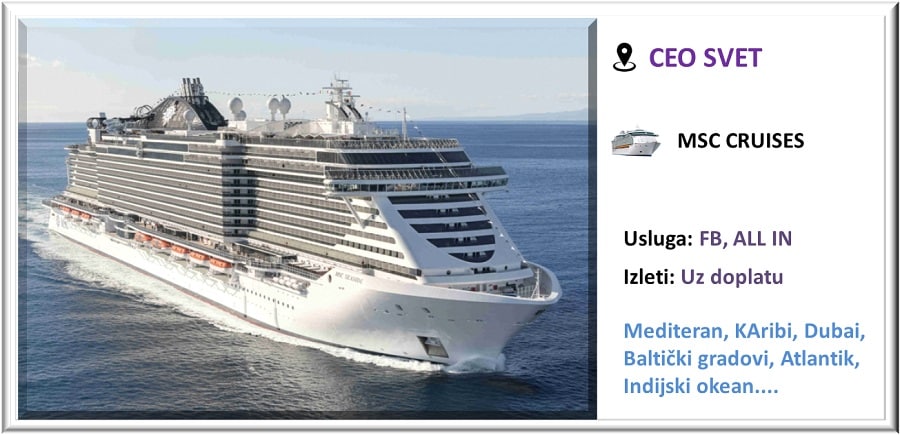
Za sva ostala krstarenja koja nisu u ponudi pošaljite nam upit:
Molimo Vas da u poruci navedete termine i broj noćenja putovanja kao i koji deo sveta želite da posetite!
Molimo da stavite napomenu da li želite avio polazak/transfer iz Beograda do luke.

[email protected] | +387 61 090 097 | Pon-Pet: 10:00 - 17:00

- Rezervacije
- Uslovi putovanja
Ako ste ljubitelj grupnih putovanja, Mondoco za vas uvijek ima ažurne grupne polaske sa obilaska Mediterana, Baltika, Kariba do Dalekog istoka i mnogih drugih atraktivnih destinacija. Ako ste ipak pobornik individualnih putovanja i želite da sve bude organizirano u skladu sa vašim slobodnim vremenom, prepustite to našem timu koji će se potruditi da vam vrijeme organizuje na nekim od najzanimljivijih destinacija. Naš tim će Vam olakšati putovanje do luke ukrcaja ili neke udaljenije destinacije, najbržim i najpovoljnijim avio ponudama i transferima, te tako putovanje učiniti nikad bližim i nikad lakšim. Ako ste oduvijek željeli krstariti nekim od luksuznih kruzera i uživati u svim čarima mora, probuditi se svako jutro u drugom gradu, tu smo da ispunimo vaše želje...

KRSTARENJE - ISTOČNI MEDITERAN
KARAKTERISTIKE KRSTARENJA: 8 dana, Costa Venezia (brod), Turska, Grčka CIJENA: za više informacija kontaktirati agenciju Mondoco.
NAČIN REZERVISANJA
- Za rezervaciju je potrebno poslati imena, prezimena i kontakt telefon na jednu od ponuđenih adresa:
- na Mail ([email protected])
- sms ili viber porukom na broj (+387 61 090 097)
- popuniti online formular- REZERVIŠI KRSTARENJE
NAČIN PLAĆANJA
- Plaćanje se vrši putem žiro računa – 140 101 112 0067 569 (Sberbank)
- Plaćanje možete izvršiti dolaskom u našu agenciju.
INFORMACIJE O AGENCIJI
- Mondoco društvo za turizam i usluge d.o.o. Sarajevo
- Terezije bb (Centar Skenderija) , 71000 SARAJEVO
- ID broj: 4202410710001
- Za ovaj program važe OPŠTI USLOVI PUTOVANJA Turističke agencije MONDOCO, a usklađenim sa UTA BIH Standardima. Uslove putovanja možete pronaći na web linku : https://mondoco.ba/uslovi_putovanja
Terezije bb, Centar Skenderija
Telefon: +387 61 090 097
E-mail: [email protected]
Kontaktirajte nas
Aktuelni događaji, pratite nas na facebooku.
© Copyright 2017 Mondoco d.o.o. Sarajevo
- +385 (0) 91 22 000 68
- [email protected]
- Radnim danom 09:00 – 16:00
- Mogućnosti plaćanja
- Opći uvjeti putovanja
- Novosti & blog
- Pošalji upit

MSC Sinfonia iz Splita - ljeto 2024
Kratki opis.
Hrvatska - Italija - Grčka, polasci od travnja do studenog
Zaplovite brodom MSC Sinfonia istočnim Mediteranom!
Sve cijene su informativnog tipa, izražene za najpovoljnije dvokrevetne kabine bella kategorije, cijene podložne promjenama prema cjenicima MSC Cruises. Za djecu do 18 godina vrijede paušalne cijene na trećem i četvrtom ležaju.
Više informacija o kategorijama kabina (bella ili fantastica experience) na prodajnom mjestu, broj višekrevetnih kabina je ograničen.
Program putovanja
Putovanje brod.
MSC Sinfonia - itinerer i opis kabina
Čak i prije nego MSC Sinfonia krene na svoje putovanje, ukrcaj na brod izgleda kao putovanje otkrića. Sa svojim impresivnim brojem preuređenih prostorija i sadržaja brod nudi još bolju opremljenost za sve svoje putnike.
UNUTARNJA KABINA - kabine od približno 13 m².* PROZORSKA KABINA - prozorske kabine s pogledom na more približne površine od probližno 15m².* BALKONSKA KABINA - kabine s balkonom približne površine od 15 do 20 m². - brod MSC Sinfonia ima mali broj balkonskih kabina u odnosu na unutarnje i prozorske.
Bračni krevet se na zahtjev može pretvoriti u dva zasebna ležaja. Sve kabine sadrže: klimatizacija, garderobni ormar, kupaonica s kadom ili tušem, interaktivni TV, telefon, bežični internetski pristup (uz naknadu), mini bar, sef.
Termini i cijene putovanja
04.05.2024. - 11.05.2024.
11.05.2024. - 18.05.2024.
25.05.2024. - 01.06.2024.
01.06.2024. - 08.06.2024.
08.06.2024. - 15.06.2024.
15.06.2024. - 22.06.2024.
22.06.2024. - 29.06.2024.
29.06.2024. - 06.07.2024.
20.07.2024. - 27.07.2024.
27.07.2024. - 03.08.2024.
03.08.2024. - 10.08.2024.
10.08.2024. - 17.08.2024.
17.08.2024. - 24.08.2024.
24.08.2024. - 31.08.2024.
31.08.2024. - 07.09.2024.
07.09.2024. - 14.09.2024.
14.09.2024. - 21.09.2024.
21.09.2024. - 28.09.2024.
19.10.2024. - 26.10.2024.
Tečaj konverzije 1 EUR = 7,53450 kn
Napomena: Prikazana cijena je izražena po osobi u dvokrevetnoj smještajnoj jedinici.
Važne informacije
- Za putovanje je potrebno imati važeću osobnu iskaznicu ili putovnicu (ovisno o destinacijama)
- Prilikom potvrde krstarenja obavezno je popuniti obrazac za krstarenja, koji šaljemo uz ugovor, koji sadržava sve bitne podatke za unos u ukrcajnu kartu.
- Djeca do 18 godina na trećem i četvrtom ležaju plaćaju paušalnu cijenu / cijena na upit.
- Jednokrevetne kabine moguće uz doplatu / cijena na upit
Brodar zadržava pravo izmjene itinerera ovisno o trenutnoj situaciji u lukama pristajanja.
Kategorizacija broda odgovara službenoj kategorizaciji brodara/organizatora krstarenja. Nevaljane putne isprave koje imaju za posljedicu odustajanje od putovanja ni u kojem slučaju ne obavezuju organizatora putovanja te se primjenjuju uvjeti otkaza putovanja. Molimo da provjerite točnost Vašeg imena i prezimena na ugovoru o putovanju u odnosu na putni dokument (putovnica ili osobna iskaznica ovisno o destinaciji u koju se putuje). Ukrcajne karte vam dostavljamo e-mailom najkasnije 2 dana prije putovanja – to je dokument potreban za ulazak na brod i bez njega se putnik ne može ukrcati. Promjena imena putnika nije moguća bez odobrenja odgovornog organizatora uz naknadu koja se propisuje. Molimo da se o sigurnosti putovanja informirate u Ministarstvu vanjskih poslova ili na web stranici: www.mvep.hr Upute i opći uvjeti putovanja za turističke aranžmane sastavni su dio programa i Ugovora o putovanju. Svojim potpisom na Ugovoru o putovanju suglasni ste s navedenim uvjetima, stoga molimo cijenjene putnike da pozorno pročitaju uvjete. Odgovorni organizator:MSC Krstarenja d.o.o.
Elite Travel d.o.o - Putnička agencija | [email protected] | OIB: 58914751045 | ID CODE: HR-AB-20-090002185 Poslovnica Zagreb, Wespa Business & Lounge, Green Gold centar, Radnička cesta 52 | tel. + 385 (0) 91 2200 068 Sjedište Putničke agencije: Dubrovnik Vukovarska 17 | tel. + 385 (0) 20 358 200
Travelife certifikat
Novosti & blog.

Novosti 11.04.2024.
Prvi let avionom
Putovanje avionom može biti uzbudljivo iskustvo, ali za one koji to rade prvi put, može biti i pomalo zastrašujuće. Ne brinite, ovdje su neki savjeti koji će Vam olakšati putovanje.

Novosti 19.03.2024.
Norveška, zemlja fjordova, planina i zelenila
Norveška, skandinavska zemlja na sjeveru Europe, očarava posjetitelje svojim veličanstvenim fjordovima, snježnim planinama, prostranim šumama i bogatom vikinškom poviješću.
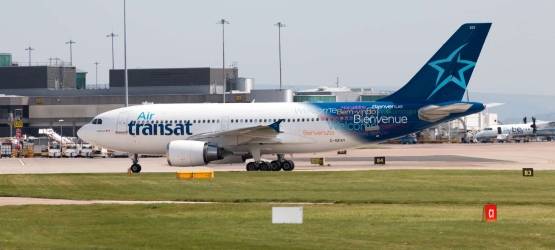
Novosti 26.02.2024.
Sanjate o Torontu? Elite Travel vam otvara vrata Kanade direktnim letovima Air Transata
Otkrijte čari Toronta i Kanade ovog ljeta s Air Transatom! Elite Travel vam s ponosom nudi izravne letove iz Zagreba u Toronto, otvarajući vam vrata u nezaboravno iskustvo.

Novosti 17.02.2024.
Zašto zamijeniti običan odmor krstarenjem?
Putujete li redovito na ista mjesta, s istim rutinama i dosadnim aktivnostima? Želite li iskusiti nešto novo i uzbudljivo, a da pritom ne žrtvujete udobnost i opuštanje? Ako je vaš odgovor potvrdan,…

Novosti 06.02.2024.
Hrana i piće za okusiti u Barceloni
U Barceloni ne samo da ćete se kulturno uzdići, nego ćete se tamo i odmoriti i istinski uživati. Kada ste tamo, dajemo Vam listu hrane i pića nezaobilaznih za taj divan kraj.

Novosti 01.02.2024.
EUROPSKO NOGOMETNO PRVENSTVO 2024.
EURO 2024. u Njemačkoj svi napeto iščekuju kao i zlatnu medalju naših Vatrenih. Hrvatsko srce kuca kao jedno i kad je nogomet u pitanju, a Hrvatska nogometna reprezentacija uvijek nas okupi na jedno…

Novosti 24.01.2024.
5 mjesta obavezno za posjetiti u Rimu
Rim je grad nevjerojatno bogate povijesti i kulture, a mi vam donosimo nekoliko mjesta koje morate obavezno posjetiti u Rimu.

Novosti 23.01.2024.
Bella Italia
Italija je dragulj koji uvijek ima nešto novo za ponuditi. U bilo koje doba godine, Italija oduševljava putnike diljem svijeta koji se uvijek iznova vraćaju.

Novosti 09.01.2024.
Španjolska, san svakog putnika
Španjolska, zemlja koju svaki putnik želi bar jednom posjetiti. Blaga klima, vrhunska hrana, vino, kulturne znamenitosti i prirodne ljepote. Što više jedan putnik može poželjeti?

Novosti 03.01.2024.

Istanbul u proljeće: kulturna i povijesna čarolija uz Elite Travel
Istanbul. Grad na dva kontinenta, između dva mora. Prijestolnica triju velikih carstva, Rimskog, Bizantskog i Osmanskog, čeka da vam ispriča svoju priču.

Novosti 18.12.2023.
Elite Travel daruje: Vikend u Opatiji!
Sezona je darivanja, a ove godine Vaš Elite Travel želi podijeliti poseban dar sa svima! Osvojite vikend u Opatiji!

Novosti 30.11.2023.
Stiže nam Advent
Svake godine krajem studenog, početkom prosinca s radošću ulazimo u blagdanski duh i iščekujemo blagdane i polako rješavamo zaostatke godine iza nas.
Ova web stranica radi boljeg rada i poboljšane funkcionalnosti koristi kolačiće (eng. cookies) i slične tehnologije. Ako nastavite s pregledom stranice, smatrat ćemo da ste suglasni s navedenom uporabom. Više informacija »
- Skala Furka
- Mola Kaliva
- Vrasna Beach
- Olympic Beach
- Leptokarija
- Pelion hoteli 3*
- Pelion hoteli 4*
- Pelion hoteli 5*
- Krit – Hanja
- Rafailovići
- Eleni resort
- Sunčev breg
- Bosna i Hercegovina
- Belgija i Holandija
- Jesenja putovanja
- Nova Godina
- Individualni polasci
- Grupni polasci
- Vikend putovanja
- BiH – Jahorina
- Grčka – bus prevoz
- Crna Gora – bus prevoz
- Bugarska – bus prevoz
- Dan primirja
- Sretenje / Dan Zaljubljenih
- Prolećna putovanja
- Uskrs / Prvi maj

Krstarenje Arapske metropole – MSC Euribia – 7 noćenja

MSC Krstarenja VELIKA AKCIJA – 96h promo do 23.04.

Krstarenje zapadni Mediteran & Portugal – MSC Orchestra – 10 noćenja

Krstarenje zapadnim Mediteranom – MSC Seaside – 7 noćenja
Krstarenje norveškim fjordovima – msc euribia – 9 dana / 8 noćenja – polazak iz beograd – avion + brod.

Krstarenje zapadnim Mediteranom – MSC Fantasia – 7 noćenja

Krstarenje zapadnim Mediteranom – MSC World Europa – 7 noćenja
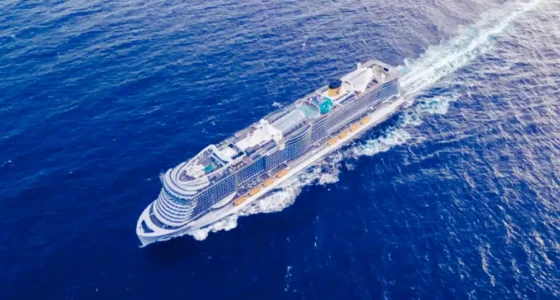
Krstarenje zapadnim Mediteranom – Costa Smeralda – 7 noćenja

Krstarenje Zapadnim Mediteranom – Brod Costa Toscana – 8 dana / 7 noćenja

Krstarenje zapadnim Mediteranom – MSC Grandiosa – 7 noćenja

Jesenje krstarenje Mediteranom – Costa Fortuna – 9 dana / 6 noćenja – polazak iz Beograda – bus + brod + hotel

Krstarenje istočnim Mediteranom – MSC Opera – 7 noćenja

Krstarenje Mediteranom iz Đenove – Brod MSC Seaview – 7 noćenja

Krstarenje Mediteranom iz Đenove – 1. maj – MSC Splendida – 9 dana / 6 noćenja – polazak iz Beograda / bus + brod

Krstarenje Egejem iz Soluna 2024 – Celestyal Journey – 8 dana / 7 noći

Krstarenje Egejem iz Atine 2024 – Celestyal Discovery 5 dana / 4 noći

Krstarenje Egejem iz Atine 2024 – Celestyal Discovery 4 dana / 3 noći

Krstarenje Neodoljivi Karibi – MSC Divina – 16 dana / 14 noćenja – Polazak iz Beograda – avion + brod
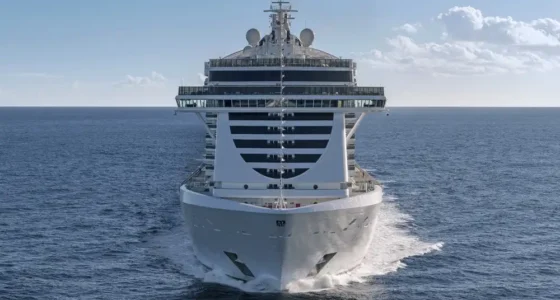
Krstarenje Mediteranom iz Đenove – MSC Seaside – 11 dana / 8 noćenja – polazak iz Beograda / bus + brod – proleće

Krstarenje Mediteranom iz Savone – Costa Fascinosa – 12 dana / 11 noćenja – polazak iz Beograda / avion + brod
Mayak tours.
- Turistička agencija MAYAK TOURS DOO
- Licenca: OTP 37/2022 od 07.04.2022.
- Kategorija: A
- PIB: 107349243
- Matični broj: 20785497

- Opšti uslovi putovanja
- Ugovor o subagenturi
- Politika privatnosti
Napomena: Sajt je informativnog karaktera. Iako nastojimo da ga redovno ažuriramo, postoji mogućnost različitih informacija od trenutno važećih. Molimo Vas da sve informacije proverite direktno u agenciji putem telefona, e-mail-a ili lično. Mayak Tours © 2021

- Istočni mediteran
- Zapadni Mediteran
- Severna Evropa
- Grupna krstarenja
- Specijalne ponude
- Put oko sveta
Krstarenja - opširnije
Krstarenja sa dobro osmišljenim itinererom i profesionalnim vođenjem, na kruzerima renomiranih kompanija kao što su MSC, Costa Cruises, Celestyal Cruises... Destinacije na obalama mora širom sveta o kojima ste oduvek maštali - grupna krstarenja, put oko sveta brodom, topla mora, prekookeanska krstarenja, plovidba Skandinavijom, Egejem ili Mediteranom. Rezervišite svoje mesto na vreme!
Krstarenje – pustolovina na moru kao iz omiljenih filmova! Uživajte u čarima mora i plovidbe istražujući osunčane predele Egeja i Mediterana ili impresivne fjordove severne Evrope. Otkrijte zašto putovanja modernim kruzerima predstavljaju jedan od najeksluzivnijih vidova odmora.
Tražite idealno letovanje za porodicu, želite da iskusite uzbudljivu avanturu sa prijateljima ili da se opustite na romantičnom putovanju? U svim ovim slučajevima krstarenje je sjajan izbor – na vama je samo da odaberete rutu i odlučite koliko vremena želite da provedete na brodu - tri, sedam ili osam dana ili pak čitave dve nedelje!
Krstarenja su stekla veliku popularnost upravo zato što nude bezbroj prilika za istinsko uživanje. Plovidba brodom, vrhunski smeštaj u brodskim kabinama, bogata gastronomska ponuda, kao i razne mogućnosti za provod i opuštanje, samo su neki od razloga da se odlučite za plovidbu kruzerima.
Programi krstarenja u organizaciji Supernova travel zavise od destinacija koje se obilaze, ali je koncept uglavnom isti – svakog dana kruzer pristaje u novu luku i pruža vam se prilika da za kratko vreme obiđete neka od najatraktivnijih evropskih ostrva, poznate primorske gradove Evrope i atrakcije u njihovoj blizini.
Izaberite idealno krstarenje za vas!
Supernova travel organizuje više od 100 različitih ruta za krstarenje. Kruzerima čije rute su u sklopu naše ponude možete krstariti istočnim i zapadnim Mediteranom, Egejskim morem i severnom Evropom , Karibima, Južnom Amerikom, Arapskim zalivom… Upoznajte ikone Egeja ili krenite putevima sedam svetskih čuda. Posetite najlepše gradove severne Evrope u julu ili pak iskusite jesen na sunčanom Mediteranu.
U zavisnosti od odabrane rute, plovidbu možete optočeti iz Soluna, Atine, Trsta, Manfalkonea, Đenove, Venecije, Kopenhagena… Nudimo aranžmane u prolećnim, letnjim i jesenjim terminima, u trajanju od 3, 4, 5, 7, 8 i 14 noći na brodu. U našoj ponudi imamo čak i aranžmane za put oko sveta od 118 dana . Pogledajte detaljnu ponudu naših krstarenja i rezervišite na vreme rutu koja vam najviše odgovara.
Upoznajte naše brodove: sadržaji na kruzerima kojima ćete krstariti
Brodske kompanije sa kojima sarađujemo su u samom vrhu ovog oblika turizma. Njihovi luksuzni kruzeri su pravi putujući hoteli na vodi , i poseduju sve što vam je potrebno za savršen odmor. U zavisnosti od toga koje doba godine izaberete za krstarenje, možete uživati na bazenima, u sunčanju na palubi ili pak u brojnim sadržajima u zatvorenom.
Na većini brodova dostupne su najrazličitije aktivnosti – teretane, fitnes, spa i wellness centri, igraonice za decu, bioskopi, pozorišta, objekti u kojima se organizuju svirke uživo i noćne žurke, karaoke i plesne večeri, kazina. Ukoliko pak tražite potpuno opuštanje i mir, krstarenje može biti idealna prilika da čitate – čak i ako ne ponesete svoje knjige, na skoro svakom brodu možete pronaći knjižaru ili biblioteku. Wi-Fi mreža je takođe na raspolaganju putnicima kruzera, a pristup internetu uglavnom je moguć uz doplatu.
Što se gastronomske ponude i ishrane tokom plovidbe tiče, uobičajeno je da imate na raspolaganju švedski sto u restoranu, ali se jelovnik može razlikovati od broda do broda.
Plovidbe koje organizujemo realizuju se brodovima renomiranih kompanija Celestyal Cruises, MSC Cruises, Costa Cruises, Royal Caribbean, Holland America Cruise Lines, Princess Cruises.
Celestyal Cruises je dobitnik više od 60 prestižnih turističkih nagrada i priznanja. Nudi all inclusive aranžmane za 3,4,7 ili 14 noćenja, a kruzerske linije pokrivaju Grčku i grčka ostrva, Egej i Mediteran. Njihovi kruzeri su pre svega jako popularni za krstarenja grčkim ostrvima i istočnim Mediteranom. Supernova nudi aranžmane za dva broda ove kompanije: Celestyal Crystal (kapaciteta 1200 putnika) i Celestyal Olympia (1600 putnika).
MSC Cruises je treći najveći brend u svetu za krstarenja i najbrže rastuća kompanija u ovoj industriji. Apsolutni su lider kada je reč o kruzerskim putovanjima u Evropi, Južnoj Americi i Južnoj Africi, a imaju snažno prisustvo i u oblastima Kariba, Severne Amerike i Dalekog Istoka. Deo su MSC grupe (Ženeva, Švajcarska), kao vodećeg privatnog konglomerata za brodski transport i logistiku u ovoj zemlji. MSC brodovi plove tokom čitave godine u području Mediterana i Kariba, dok sezonskim intinererima pokrivaju Severnu Evropu, Južnu Ameriku, Južnu Afriku, Aziju, Dubai, Katar, Saudijsku Arabiju i Crveno more.
Smeštaj na krstarenjima
Kabine za smeštaj putnika su u svakom kruzeru kategorizovane, pa prilikom rezervacije aranžmana možete odabrati unutrašnju, prozorsku ili balkonsku kabinu . Naravno, od vašeg izbora smeštaja zavisiće i cena krstarenja. Svi naši aranžmani podrazumevaju boravak u dvokrevetnim kabinama, a cene se obračunavaju po krevetu. Međutim, uz doplatu, možete rezervisati i aranžman u trokrevetnim i četvorokrevetnim kabinama, pod uslovom da su u trenutku rezervacije još uvek dostupne.
U svim kabinama su udobni, novi kreveti koji će vam omogućiti da se pristojno odmorite nakon dnevnih aktivnosti na brodu i obilaska destinacija na odabranoj ruti. Kabine su opremljene kupatilom i tuševima, LCD televizorom, sefom, minibarom i drugim sadržajima koji garantuju vrhunski komfor.
Cene krstarenja
Iako krstarenja spadaju u luksuzni oblik turizma, cene Supernova travel aranžmana su pristupačne, posebno ako se uzmu u obzir naše specijalne ponude. First minute krstarenja su savršena prilika da po izuzetno povoljnoj ceni rezervišete vrhunski turistički aranžman i plovidbu koju ćete dugo pamtiti i prepričavati.
U svakom slučaju, na svim našim brodovima postoje tri kategorije kabina, a od toga koju od njih odaberete za smeštaj tokom krstarenja zavisiće i cena aranžmana. Najjeftinija opcija su unutrašnje kabine, zatim prozorske, dok ćete najveću sumu morati da izdvojite ukoliko se opredelite za luksuzne balkonske kabine.
Šta sve uključuje cena aranžmana za krstarenje?
Ako drugačije nije naznačeno u opisu putovanja, cena krstarenja uglavnom obuhvata plovidbu prema predviđenom planu puta, smeštaj u kabinama izabrane kategorije na bazi punog pansiona ili all inclusive usluge, lučke takse, korišćenje bazena, fitnes sale, kao i rekreativno zabavne programe i animaciju dece u igraonici ili specijalizovanom prostoru za najmlađe.
Pogledajte našu ponudu ruta za krstarenje i dostupne sadržaje na brodovima kojima ćete putovati. Uz program plovidbe za svaku rutu postoji precizan cenovnik i svi sadržaji koji ulaze u osnovnu cenu aranžmana. Za zahtevnije putnike, Supernova travel nudi mogućnost doplate za dodatne brodske servise i sadržaje.
Šta sve ne obuhvata cena krstarenja?
U okviru detaljnog opisa programa putovanja možete pronaći i informacije za svako krstarenje šta ne ulazi u osnovnu cenu i koje su mogućnosti za doplatu dodatnih sadržaja . Uglavnom nisu uključeni u cenu troškovi prevoza do i od luke ukrcavanja, obavezno međunarodno zdravstveno osiguranje, pića na brodu koja ne ulaze u osnovni paket pića, fakultativni izleti, korišćenje mini bara u kabini, zabava u kazinu. Dodatno se plaćaju i ostale lične usluge na brodu poput pranja odeće, kupovine u brodskim prodavnicama, room servisa, korišćenja brodskih sredstava telekomunikacije, a na nekim brodovima i internet konekcije.
Ako vas zanimaju fakultativni izleti, u okviru svakog itinerera postoje predviđene brodske ekskurzije i cene za njih. Pročitajte uslove i način plaćanja i krenite na putovanje iz svojih snova!
U opisu svakog pojedinačnog aranžmana za krstarenje pronaći ćete detaljne informacije o planu plovidbe i o sadržajima na svakom kruzeru. Za sve dodatne informacije budite slobodni da nas kontaktirate
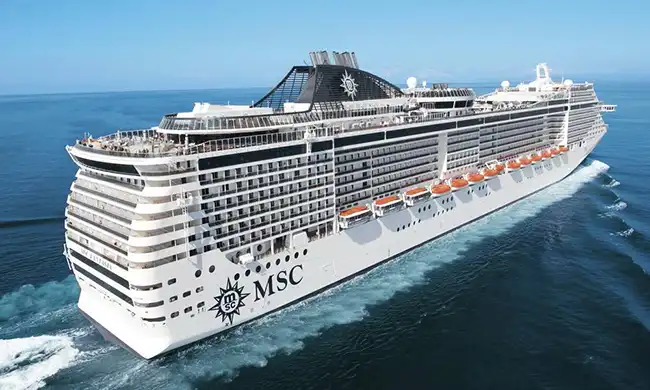
Zapadni Mediteran - Krstarenje brodom MSC Fantasia
Đenova - la spezia - napulj - palma de majorka - barselona - marsej - đenova.

Krstarenje Arapski zaliv - Dubai
Dubai - khasab - oman - muscat - oman - abu dhabi - sir bani yas is - dubai.
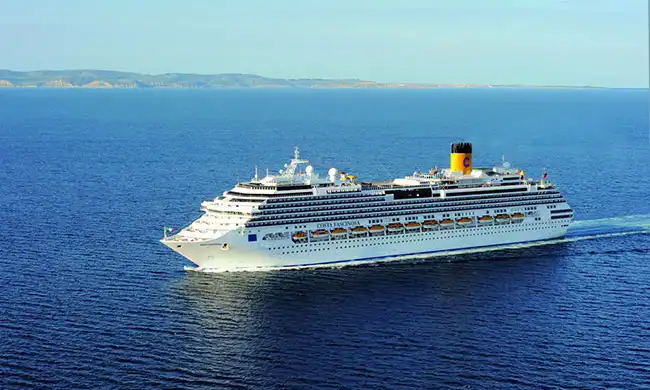
Krstarenje - Prolećni fado na Mediteranu
Milano - savona - malaga - gibraltar - kadiz - lisabon - alikante - barselona - marsej.

Grupno krstarenje - Proleće na sunčanom Mediteranu
Đenova - rim - palermo - ibica - valensija - marsej - sanremo – monako – monte karlo.

Krstarenje Zapadni Mediteran
Đenova - napulj - mesina - valeta - barselona - marsej - đenova.

Đenova - Ćivitavekija - Palermo - Ibica - Valensija - Marsej - Venecija

Krstarenje Ikone Egeja - 3 noći
Mikonos - kušadasi - patmos - heraklion - santorini - atina, krstarenje ikone egeja - 4 noći, atina - mikinos - kušadasi - patmos - rodos - krit - santorini.

Krstarenje Zapadnim Mediteranom do Lisabona
Đenova - marselj - malaga - kadiz - lisabon - alikante - mahon - olbia - đenova.

Krstarenje Idilični Egej, Solun - First Minute
Solun - kušadasi - efes - heraklion - santorini - mikinos - milos - pirej - solun.

Zapadni Mediteran - Krstarenje brodom Costa Smeralda
Đenova - marsej - barselona - kaljari - napulj - rim - đenova.

Krstarenje 15 dana Sredozemljem
Savona - rim - cadiz - lisabon - gibraltar - kazablanka - valensija - barselona - marcelj - savona.

Krstarenje Mirisi Egeja
Atina – mikonos – kušadasi – patmos – rodos – krit – santorini.

Prvomajsko krstarenje mediteranom
Venecija – đenova – marsej – barselona – sanremo – kan – nica – eze – outlet seravalle.
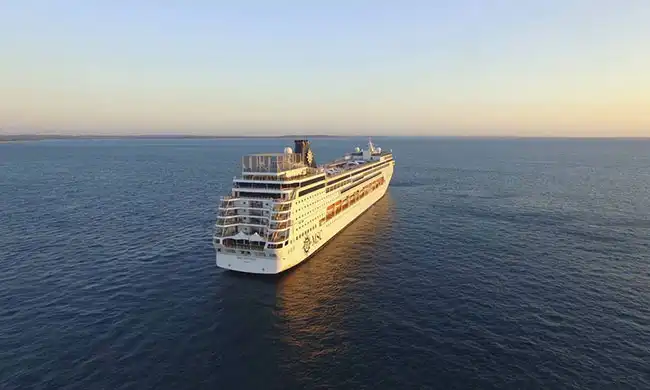
Istočni Mediteran - krstarenje brodom MSC Sinfonia
Split (zadar) - venecija - brindisi - mikinos - pirej.
Strana 1 od 4
- 3 do 5 noći (2)
- 6 do 8 noći (36)
- 9 i više noći (13)
- januar (12)
- februar (9)
- avgust (25)
- septembar (24)
- oktobar (23)
- novembar (13)
- decembar (10)
- Celestyal Discovery (3)
- Celestyal Journey (1)
- Costa Deliziosa (3)
- Costa Diadema (2)
- Costa Fascinosa (2)
- Costa Favolosa (2)
- Costa Fortuna (4)
- Costa Pacifica (1)
- Costa Smeralda (2)
- Costa Toscana (2)
- Cunard Queen Victoria (1)
- MSC Armonia (1)
- MSC Euribia (3)
- MSC Fantasia (3)
- MSC Grandiosa (1)
- MSC Lirica (2)
- MSC Magnifica (2)
- MSC Musica (1)
- MSC Opera (2)
- MSC Orchestra (1)
- MSC Poesia (2)
- MSC Preziosa (2)
- MSC Seaside (2)
- MSC Seaview (1)
- MSC Sinfonia (3)
- MSC Splendida (2)
- MSC World Europa (2)

- United Arab Emirates
- Switzerland
- The Netherlands
- Puerto Rico
- United States
- New Zealand
- ➨ Choose from World Map
- Budget Travel
- Family Travel
- Getting Around
- Visas & Passports
- Work with Us
Browsing Category
- Czech Republic
- Saint Martin
- Uncategorized

Moscow Travel Guide: Best Things to Do + More [2023]
· everything to know about visiting moscow, including the best things to do and how to get around. ·.

Moscow is Russia’s vibrant capital city, and it also happens to be the largest city in all of Europe. The city’s long and infamous history makes it one of the most unique places we have ever visited.
The architecture ranges from centuries-old palaces to uniform, gray concrete buildings. The people range from cold and private to warm and welcoming. Moscow is a city is strong juxtapositions, and we learned a lot during our time there.
This post will break down all you need to know about visiting Moscow, including the best things to do, how to get there, how to get around, and more.

The Best Things to Do in Moscow
1. explore the red square.
The Red Square is the heart of Moscow. Most of the city’s top attractions can be found here, including just about everything on this list. The Kremlin, St. Basil’s Cathedral, and Lenin’s Mausoleum are all located here, and the State Historical Museum and GUM are not far from here, either.
The Red Square is a common home for parades, protests, and seasonal celebrations. There are massive Christmas celebrations here, with food vendors and carnival rides set up in numbers.

2. Check Out the Ziferblat
The Ziferblat is a café in Moscow that is unlike any café we have ever been to. While most cafes charge you for your drinks and food, the Ziferblat charges you for your time.
Upon arrival, you are given a clock. When you leave, the barista calculates how much time you spent in the café and charges you accordingly. This concept was created to help visitors to be more intentional with their time, and the cafe itself is incredibly charming.
For a detailed look at everything you need to know before you visit, make sure you read my post about visiting the Ziferblat Cafe in Moscow .

3. Marvel at St. Basil’s Cathedral
St. Basil’s Cathedral is one of the most iconic churches in the world, and it was the single thing we were most excited to see while in Moscow. Built almost 500 years ago, St. Basil’s Cathedral is recognized by its colorful domes and whimsical style. The church is of the Russian Orthodox faith, and the inside is just as wondrous as the outside.
St. Basil’s Cathedral is located on the edge of the Red Square, making it incredibly convenient to visit. Entrance for non-worshippers costs 800 rubles, and tickets can be bought at the church

4. Explore the Kremlin
The Kremlin is the largest active fortress in Europe, and it is the site of most of Russia’s government affairs. In addition to government buildings, the Kremlin Complex is filled with courtyards, towers, and museums that are open to the public. If you have the time, you could spend a couple of days fully exploring all that there is to see in the Kremlin.

5. Walk Through Lenin’s Mausoleum
Vladimir Lenin is one of the most important figures in Russian history, and his body is located perfectly embalmed in a mausoleum in the Red Square. The Mausoleum is open to the public to visit, and as long as you are willing to go through a few security checks, it is easily one of the best things to do in Moscow. Its convenient location in the Red Square makes it a can’t miss attraction.
There is absolutely no photography allowed inside the Mausoleum. Do not test this rule.

6. Wander Along Arbat Street
The Arbat is a very popular street in Moscow that is lined with stores, cafes, and other touristy attractions. It is one of the oldest streets in the city, dating back to the 1400s. This street is both quaint and trendy, and there are many walking tours that introduce tourists to the neighborhood’s wonders and highlights.

7. Catch a Show at the Bolshoi Theatre
As a lover of the arts, it is hard to think of Moscow and not think of ballet. Russia has always been a top dog in the world of fine arts, and Bolshoi Theater is one of the best places to catch a performance. We were lucky enough to attend an Opera here, and it is a venue that you don’t want to miss out on if you enjoy opera, ballet, or orchestral performances.
8. Visit the State Historical Museum
The State Historical Museum is one of the most respected museums in Moscow. Despite its name, it is not really focused on the history of Russia as a nation. Rather, it contains a collection of artifacts from all throughout Russia’s history.
The museum’s collection is very broad in nature. It houses some items from indigenous tribes that used to occupy the region, pieces collected by the Romanov family, and more.
9. Wander Around GUM
GUM is an absolutely massive mall within walking distance of the Red Square. It isn’t just the size that draws visitors here; it’s the sense of luxury. The mall is so beautiful inside, much like the metro stations.
While visiting a mall might not sound like it belongs on a bucket list, this mall does. You will not want to miss out on visiting GUM while in Moscow.

10. Admire the Cathedral of Christ the Saviour
While St. Basil’s Cathedral is the most iconic church in Moscow, it isn’t the only one. The Cathedral of Christ the Saviour is absolutely stunning, with massive golden domes. It is the tallest Orthodox church in the world, and it is the seat of the Orthodox Patriarch of Moscow.
It is located just about a mile from the Red Square, just south of the Kremlin Complex. You can walk to it from the Red Square in about 20 minutes.
How to Get to Moscow
Flying to moscow.
Moscow has three major international airports: Sheremetyevo (SVO) , Domodedovo (DMO) , and Vnukovo (VKO) . All three of them are directly connected to downtown Moscow by the Aeroexpress trains, which leave every 30 minutes throughout the day. By Aeroexpress train, you can expect to get to the city center in 25-45 minutes depending on the airport that you fly into.
Sheremetyevo is the biggest and busiest of the three airports, and it is the one you are most likely to fly into – especially if you are coming from outside of Europe or the Caucus region. We flew into Sheremetyevo on a direct flight from New York City.
I usually provide backup airport options, because flying right into the city isn’t always the cheapest way to get where you’re going. Unfortunately, when it comes to Moscow, don’t really have a choice other than to fly right into Moscow. It is a very remote city, and it is usually the cheapest place to fly into in Russia as a whole.
Since Sheremetyevo is so busy, you will probably find a great flight option anyway. I wrote in my post about finding cheap flights that using hub airports will lead to more affordable airfare, and the same logic applies here. Even though Russia’s national airline, Aeroflot, is no longer a member of the SkyTeam Alliance, Moscow is still a major hub connecting passengers from all over the world.

READ OUR CHEAT SHEET
Train or Bus to Moscow
Trains and buses are one of the most popular ways to get around Europe. However, they’re of very little use when you’re trying to get to Moscow.
Moscow is hundreds of miles from the nearest major cities. The only major European city that can even be reached within 8 hours on the ground is St. Petersburg, and even the Baltic capitals of Riga, Vilnius, and Tallinn are over 12 hours away.
If you want to get to Moscow, the best option is almost always to fly. While the train routes to Moscow are scenic, they simply take forever.
How to Get Around Moscow
METRO | TROLLEYS | TRAMS | BUSES
Moscow has one of the most memorable metro systems in the world. Its metro lines are very deep underground, and the stations are absolutely stunning. Each station has its own unique style, but all of them contain escalators that seem to go on forever.

The system was built in an effort to showcase the power of the Soviet Union and its bright future. The plans were a form of propaganda, but they resulted in what is still one of the most visually appealing subway systems on earth.
Moscow’s metro system isn’t just pretty. It is also very useful and accessible. The system has 17 lines that connect the city and its surrounding area.
But wait; there’s more!
The Moscow metro system is also incredibly affordable, with each ride costing less than a dollar. The metro is by far the best way to get around Moscow, as it is almost impossible to beat the connection times and the low cost to ride.
Tickets can be bought at electronic, English-speaking kiosks in stations, or directly from ticket counters at certain larger stations. There are also day passes available, which are a very solid option if you plan on riding the metro several times per day.

The metro is by far the best way to get around Moscow.
In addition to the metro system, Moscow also has a network of buses, trams, and trolleys. This system is nowhere near as convenient or well-connected as the metro, though, and is likely of little use to you during your trip. There is no Uber in Moscow, but a similar app named Yandex is available if you need a ride in a pinch.
How Many Days Do You Need in Moscow?
Moscow is the biggest city in all of Europe, and it is absolutely loaded with things to do. You could spend weeks in Moscow and still find new things to do. Of course, most travelers don’t have that kind of time to spend in one place!
I recommend spending no less than three full days in Moscow, and ideally closer to five or seven.
Moscow is very spread out, and it can take some time to get from one major point to another. There are also so many places that are nice to just sit back and relax, which is hard to do when you’re in a hurry trying to cram activities into just a few days.
If you only have a week to visit Russia, I’d advise spending all of the time in one city. If you decide to split your time between Moscow and St. Petersburg, I recommend not trying to squeeze in any day trips beyond those two cities.

When Is the Best Time of the Year to Visit Moscow?
There are two different ways to approach this question. Personally, I think the best time to visit Moscow is around Christmas and New Year’s Day. While the weather will be absolutely freezing, Moscow is a surreal winter wonderland in December and January.
We were in Moscow right before Christmas. While it was very cold, you can always bundle up. Exploring the Christmas markets and pop-up ice skating rinks throughout Moscow is one of my favorite memories from anywhere I’ve traveled, and I dream of going back to do it again.
If you aren’t fond of the cold, Moscow is beautiful in the summer. It tends to get pretty cold in the shoulder seasons, so if you want warm weather, you should plan to visit in the summer. Moscow actually gets pretty warm in July and August, and there are a bunch of fantastic places to soak up the sun within the city.
The best time to visit Moscow is either around Christmas or from late May to August.

Is Moscow Safe to Visit?
While Moscow is a truly wonderful city, there’s no denying that visiting Russia comes with risks. As the country is run by an infamous communist dictator, concerns about visiting are valid. While we didn’t experience any sort of threat or negative treatment during our time in Moscow, we visited in a peaceful time.
In our experience, Russia doesn’t seem to detain normal Americans or Westerners to use as pawns. As a regular person, as long as you don’t commit any crimes, there is a slim chance you will run into any issues. However, Russia will not hesitate to enforce its laws against foreigners, and illegal behaviors will likely land you in a very compromising position.
Russia will not hesitate to enforce its laws against foreigners, and illegal behaviors will likely land you in a very compromising position.
To make matters worse, Russia has a bad reputation for gang violence. While the Russian mafia has very little interest in normal Western tourists, they won’t hesitate to pick a fight with anyone who ventures into their sphere of influence. If you seek out illegal substances or activities, you could be a target of the mafia.
If you seek out illegal substances or activities, you could be a target of the mafia.
Finally, since Russia’s invasion of Ukraine, things are all very different. Russia is currently at war, and there are battles raging within 8 hours of Moscow. While it is still relatively safe to visit, that could change at any time as the war with Ukraine continues.
Is Moscow Worth Visiting?
Without a doubt, Moscow is worth visiting. It is one of the most unique major cities we have ever visited, and we hope to make it back one day. The Russian Orthodox churches are stunning, the city’s history is unlike any other, and the food is to die for.
While many visitors prefer St. Petersburg to Moscow, I think Moscow deserves a lot of hype of its own. Moscow is the beating heart of Russian culture and history, and it’s a place I highly recommend checking out if you have the chance.

That’s all we have for you about Moscow! I hope this post was helpful as you plan your trip to Russia’s capital.
Have you been to Moscow? Or is this your first time visiting? Comment below if you have anything to add to our travel guide!
Hi, I'm Greg. I'm an avid traveler who has traveled to over 50 countries all around the world with my wife and kids. I've lived in Italy, Mexico, China, and the United States, and I dream of moving abroad again in the future. With this blog, I provide my audience with detailed destination guides to my favorite places and pro-tips to make travel as stress-free as possible.
Leave a comment
Save my name, email, and website in this browser for the next time I comment.
Meet The Author - Greg

Recent Post

How Much Does a Trip to Egypt Cost: Budget Breakdown
March 10, 2024

Best Time to Visit the India Gate in Delhi [2024]
March 1, 2024

Flying with a Sinus Infection: Tips to Avoid Pain
February 20, 2024

11 Best Things to Do in Breckenridge Besides Skiing
February 12, 2024

10 Best Beaches in Mexico for Families (We Lived Here)
February 3, 2024

2018 Primetime Emmy & James Beard Award Winner
R&K Insider
Join our newsletter to get exclusives on where our correspondents travel, what they eat, where they stay. Free to sign up.
A History of Moscow in 13 Dishes
Featured city guides.

15 Fantastic and Easy Day Trips From Moscow
Is the hustle and bustle of Moscow starting to wear you down? No worries. There are multiple great day trips from Moscow that will let you see a different side of Russia that you won’t find in the metropolitan area. Each day trip I’ve listed below can easily be done by train from Moscow, and there are trains every day of the week.
The area surrounding Moscow is rich in cultural attractions and natural beauty. By traveling only a short distance, one feels far away from the crowds, and lines of the sprawling Russian capital. Since Russia is undoubtedly an expansive country it may take from half an hour to two hours to reach some of the landmarks on this list (by train or car) from the Moscow city center.
You can escape to the picturesque Russian countryside, visit war memorials, battlefields, admire onion-domed churches, and get insight into the local way of life. Easy day trips from Moscow include the incomparable white-stone Trinity Cathedral in Sergiyev Posad, the spectacular Cathedral of the Assumption in Dmitrov, and the Russian military aircraft in Monino. For those who love rural tranquility, Suzdal and Vladimir are a must-see. History buffs will appreciate the Patriotic War of 1812 reenactment that took place in Borodino on the first weekend of September.
Without further ado, here are 15 best day trips from Moscow that are well worth your attention.

The Best Day Trips from Moscow
There’s a reason Moscow is one of Europe’s most enigmatic destinations. It’s got culture, class, food, history, and more, but even better, is that it is the country’s main transport hub with so many attractions within a day trip from Moscow. While you can definitely spend days or even weeks in Moscow, it can, of course, be done in just one week. What can you do in Moscow in seven days ? Well, you can do a lot if you know how to plan a trip to a place you know so little about.
If you’re ready to get out of the city a bit and soak up the culture, fresh air, and enchanting architecture, I’ve rounded up my favorite day trips outside of Moscow. I often get asked: What are the best cities to visit in Russia? And these are places that I’ve been and loved.
My Favorite Easy Day Trips from Moscow:
Dmitrov Kolomna Zvenigorod Sergiyev Posad Yaroslavl Arkhangelskoye Estate Vladimir Suzdal Korolev Borodino Patriot Park in Kubinka Melikhovo Gorki Leninskie Kaluga Monino
1. Day Trip to Dmitrov from Moscow
Dmitrov may not be as popular as other cities in Russia, but the fact that the city was founded only 7 years earlier than Moscow makes for a great day trip. This small city some 90 kilometers from Moscow is particularly beautiful in the summer. As you walk the streets you can see sparkling fountains, charming centuries-old buildings, yachts and boats transiting through the canal and, of course, the Museum-Reserve Dmitrov Kremlin.
The Kremlin (castle) is the city’s main draw. The 10m high and about 1km long earthen rampart remained behind the wooden wall and gives an idea of how the castle looked like 400 years ago. The oldest surviving building on the Kremlin grounds is the 16th-century Assumption Cathedral with a unique five-tier iconostasis.

Not far from the Kremlin there is a compact 15th-century Borisoglebsky convent. Its main building – the 16th-century Cathedral of Sts. Boris and Gleb is open to the visitors only for services of worship. In the 1930s in the convent housed a labor camp, which contained the builders of the Canal named after Moscow.
Getting There: Dmitrov sits an easy hour and sixteen minutes by train from Savyelovskiy Rail Terminal. This cheap day trip from Moscow is a great chance to soak up the historic charm to be found in Moscow Oblast.
2. Day Trip to Kolomna from Moscow
Situated to the south-east of Moscow, Kolomna is a beautiful port city on the Oka River. This is one of the oldest Russian cities in the region. So you can discover the old history in museums and monasteries. Interestingly, the city was a site for important weapon factories under the Soviet Union. Although it was opened up in 1994 Kolomna is not as popular as other day-trip destinations in the region.
Nevertheless, it is a great place to visit with friends and family where you can explore the 15th-century Kremlin made of red brick, try incredibly sweet traditional pastila (marshmallow), and visit some of the cute little churches and 19th-century mansions.
Getting There: Take the express train (commuter line train) from the Kazansky rail terminal to Golutvin station. The trip lasts one hour and forty minutes.
3. Day Trip to Zvenigorod from Moscow
This one is usually a given due to its proximity to and ease of transport from Moscow. It’s one of the easiest day trips from Moscow by train. You can easily hop on the train from the city and land right in the town of Zvenigorod where you can visit the 14th-century Savvino-Storozhevsky Monastery and sample the sparkly and refreshing kvass, a Russian specialty beverage that’s enjoyed in the summer months.
Zvenigorod is an adorable little town just under an hour away from the Moscow city and is an amazing place to visit as it will give a relaxing break from the hectic life of Moscow. Check this day trip if you don’t feel like planning.
If you have a sweet tooth, spend some time in the quirky Museum of Russian Desserts, where you can indulge in uniquely delicious treats and explore the intersection of food and culture.
Then you may want to pay the Zvenigorod Museum of History, Architecture, and Art a visit. The museum’s exposition is located on the territory of the Savvino-Storozhevsky monastery, or rather, in the 17th-century Tsaritsyny chambers, built for the wife of Tsar Alexei Mikhailovich. Stroll through the museum halls to view the permanent exhibitions, which offer insights into various aspects of Russian history. The intricate museum’s building is adorned with a decorative porch, complex patterned elements, and looks very impressive in general.
4. Day Trip to Sergiyev Posad from Moscow
If you’re looking for cheap day trips from Moscow, Sergiyev Posad is a good choice at just a few dollar train ride away. Known as a major center of pilgrimage and home to one of the largest Russian Orthodox Monastery which has been here for hundreds of years, Sergiyev Posad is a fun day trip from Moscow and can be combined with Abramtsevo Museum Estate. As the only town in Moscow Region which is included in the Golden Ring of Russian cities, Sergiyev Posad is an incredible destination for a day trip from Moscow that packs UNESCO-protected Trinity Sergius Lavra, great museums, and gorgeous architecture into one day.
Make sure you see the six-pillared Assumption Cathedral that was commissioned by Ivan the Terrible in mid-16th-century and go inside to marvel at the impressive iconostasis that features Simon Ushakov’s masterpiece, the icon of Last Supper. Enjoy a delicious lamb steak with wheat kasha, Ukha fish soup, or hand-made dumplings as you learn a lot about religious and cultural history.
Getting There: Known for its small-town charm and welcoming feel, you can get to Sergiyev Posad by train, by bus, or by car. Trains depart from Yaroslavsky Rail Terminal every thirty minutes, and the trip lasts about an hour and a half. Alternatively, you can hop on a bus at the ‘VDNKh’ metro station. A bus trip to Sergiyev Posad takes two hours on average but can be reached in 90 minutes depending on traffic. If you go by car expect to spend about an hour and a half attempting to traverse the congested Yaroslavskoye highway.
5. Day Trip to Yaroslavl from Moscow
Going from Moscow to Yaroslavl may seem like a really long day trip, but honestly, if you take the comfortable train, it only takes about four hours to reach the city, so making a Yaroslavl day trip is totally doable. Although I do recommend much more than one day in Yaroslavl, especially if it’s your first time.
Cultural tourists visiting Yaroslavl should start their exploration by strolling the historic city center, a UNESCO World Heritage Site. A spacious 100-hectare area enclosed by Sobinova and Republican streets is home to most popular attractions – the 17th-century Church of Elijah the Prophet that survived almost exactly in its original form, and in contrast to it, the white stone Assumption Cathedral, restored in the 2000s.

If you walk a bit further passing the Holy Trinity sculpture and city’s foundation stone, you will find yourself at Strelka, a park on the cape, which offers panoramic views of the spot at the confluence of Volga and Kotorosl rivers. On the way back, there is a pleasant walk along the picturesque Volga embankment to the Governor’s Garden with shadowy alleys and an open-air Sculpture museum.
Getting There: Yaroslavl is about 280 km (173 miles) northeast of Moscow, so the best way to get there is to take a morning train from Yaroslavskiy Rail Terminal. A tour is also a great way to see the Yaroslavl without having to worry about driving or searching for trains. You can book a tour here.
6. Day Trip to Arkhangelskoye Estate from Moscow
Situated on the outskirts of Moscow and dates back to the late 18th-century, Arkhangelskoye Estate was the domain of the nobility for over a century until the Russian Revolution swept people who owned the estate out of the country. The estate was turned into a museum, which it remains today.

The Arkhangelskoye Estate Museum holds the largest rare-book collection. The exhibition also includes old manuscripts, historical documents, photos from the past, a vast collection of sculpture, paintings, engravings, and exceptional examples of decorative art. These art objects once belonged to Prince Nikolai Yusupov, the former owner of the estate.

Arkhangelskoye Estate is often referred to as the Russian version of Versailles because of the intricately manicured garden and beautiful 18th-century park. Famous Russian writers and poets such as Pushkin, Herzen, Mayakovsky loved to spend their free time here making long excursions in the surrounding area. Arkhangelskoye is a perfect place to appreciate the terraces decorated by delightful statues, exquisite vases, and busts.
Visitors can take tours, which introduce them to vibrant examples of Russian art and culture.
Getting There: To reach the estate it’s best to take a bus or a privately-owned minibus that departs from Tushinskaya metro station.
7. Day Trip to Vladimir from Moscow
Situated only two hours east of Moscow, Vladimir is absolutely one of the best places to visit near Moscow for a day trip. This splendid city dates back to the 12th century and has a very rich history. If magnificent Orthodox cathedrals and traditional white-stone architecture entice you, then this place is perfect for a day trip with your significant other.
First things first, you need to see the Golden Gate, which indicates the entrance into the old town. This 12th-century medieval masterpiece of military architecture is associated not only with Vladimir but with the Golden Ring tourist route itself. At the top of the gate, where once was the Church of the Deposition of the Robe, there is the Museum of Weapons. Great looking arrowheads and spear points date back to the Grand Principality of Vladimir, while the exhibition in an impressively majestic setting features a number of Batu-Khan related artifacts.
There’s a variety of attractions to put on your must-see list: the Old Believers Trinity Church right behind it, the Cathedral of St Demetrius, and Dormition (Uspensky) Cathedral. If you plan on shopping for souvenirs like birch-bark masterpieces of Kunov’s masters, drawings, carving, embossing, figures of people and animals, stop by the Lacquer Miniature, the Museum of Crystal, and the Gingerbread Museum. Many of the local attractions were added to UNESCO’s list of World Heritage sites.
Getting There: The best way to visit this area is to catch an early train from Moscow and book a full-day tour of Vladimir in advance. This one includes the town of Suzdal as well.
8. Day Trip to Suzdal from Moscow
This gem of a little medieval town perched on a hill just a 30-minute ride from Vladimir is one of those places I’ve visited and could move there permanently and be happy! It’s a charming little piece of history that also has a Kremlin and visiting it feels like stepping back in time. if you’re a culture enthusiast you’ll be glad to know there are numerous churches, five monasteries, including Spaso-Yevfimiev Monastery in Suzdal. Check them out if you want to get a real taste of the country!

pend some time shopping at the Torgovaya ploshchad (Market Square), where you can buy baskets made of birch bark, ceramic handmade plates, honey or souvenirs and, of course, grab some afternoon tea!
Getting There: Trains leave regularly from Moscow’s Kurskiy Rail Terminal to Vladimir where you can hop on a bus to Suzdal. You can also take a bus from Moscow. In this case, it might take longer and you’ll probably encounter infamous traffic jams. If you go by express train the trip takes about 1 hour and 40 minutes. There are slower trains of course, but I’d recommend going with the fast one and save a lot of time!
9. Day Trip to Korolev from Moscow
Located some 30 kilometers northeast of Moscow, Korolev has become arguably the most important space research center with skilled workers from across the Soviet Union who came here to expand the space program.
It became a leading institute dedicated to aerospace research in the country. Today, that tendency can still be clearly seen on the streets and in the buildings. When the Soviet Union collapsed, the city retained its status as the headquarters of Russia’s space surveillance network and now it hosts the Russian Mission Control Center, an analogue of the American Mission Control Center at NASA’s Space Center in Houston.
If you want to learn more about Mission Control Center and the former Russian Mir space station, book a tour with a knowledgeable guide who can clearly tell the history of this place.
If you’re not into space exploration there is also a Memorial Apartment Museum of Marina Tsvetaeva in Bolshevo. With a picturesque park next to the museum, it’s a great place for walking in the fresh air. The highlight of the park is memorial stones with quotes from Tsvetaeva’s poems.
Getting There: I’d recommend going by train. Catch one at Yaroslavskiy Rail Terminal that departs every 30 minutes to reach Bolshevo station.
10. Day Trip to Borodino from Moscow
The historic Battle of Borodino on September 7, 1812, took place just outside the small village of Borodino, about 140 km west of Moscow, and about 15 km from the nearest town of Mozhaysk. Although the French won the Battle of Borodino and went to capture Moscow, it was one of the bloodiest battles of the pre-twentieth-century that is also predetermined Napoleon’s defeat.
While it was a battlefield back then, not much remains today. It’s mostly a green and grassy field now with a few monuments of military honor, architectural objects dated back to 19th and 20th century, and fortification facilities scattered throughout the area. The largest of these is the 27-meter high obelisk located right at the heart of the former battlefield.
Every year the military and patriotic festival and theatrical performance take place in Borodino. Early September is considered to be the best for visiting. But if you just want to feel the spirit of the battle, it’s better to go at any other time of the year.
Getting there: Hop on a train from the Belorussky rail terminal, disembark in Mozhaysk, and then take a bus to the museum. The whole travel time is about 2 hours.
11. Day Trip to Patriot Park in Kubinka from Moscow
Once a Red Army tank training ground, now it’s a military Disneyland with history, structure, guns, and armored vehicles! The tank museum originally housed one of the world’s largest and rarest collections of tanks. In 2016 they combined the training grounds with the newly-created Patriot Park. Since then, some of the notable and rare items have been moved to the Patriot Park site, so you may want to combine both sites into one tour (only about 20 minutes apart).

The exhibition grounds include some very rare specimens that are must-see for any military enthusiasts out there. The staff is friendly, helpful and kind, while the museum has a small shop. As this site is part of an operating military base, they may ask you to show your passport, or provide them with a photocopy of the front pages. There are vending machines for snacks and drinks, and there are bathroom facilities. There’s plenty to see, so I recommend setting aside an entire day!
Getting there: Situated halfway between Borodino and Moscow, the best way to reach Patriot Park in Kubinka is by car. Alternatively, if you don’t want to rent one, consider car-sharing apps like Gett or UBER. The price of ride-sharing services is cheap enough to make them a viable proposition for choosing them.
12. Day Trip to Melikhovo from Moscow
Located some 80 km from Moscow, Melikhovo is one of the most important museums dedicated to Anton Pavlovich Chekhov. This renowned Russian writer and playwright acquired Melikhovo in 1892. He lived there with his parents and close relatives for 7 years before moving to the Crimea in 1899. Melikhovo is where he wrote his plays “The Man in the Case” and “The Seagull”.
The estate faded into oblivion right after the Revolution but in 1939 Anton Chekhov’s sister Maria and his nephew established a museum based on Chekhov’s place of living. The museum opened its doors to the public in 1941.
Today museum’s exhibition reveals the legacy of a celebrated writer and shows his path not only as a writer but as a doctor and public figure as well. The collection also features some of the best-known paintings by famous artists like Isaac Levitan and Vasily Polenov, who were Chekhov’s friends. When it comes to fun and educational day trips from Moscow, Melikhovo is a nice place for learning more about Chekov’s life and work.
Getting There: You can reach Melikhovo by train from Kurskiy rail Terminal. Disembark in the town of Chekhov and hop on a minibus that will get to the estate. Alternatively, hop on a bus that departs from the Yuzhnaya metro station.
13. Day Trip to Gorki Leninskie from Moscow
Once the realm of Russian nobles, Gorki Leninskie was turned into Lenin’s museum some 25 years after his death. The estate sits some 30-minute bus ride from the Domodedovskaya metro station and houses Soviet-era memorabilia and Lenin’s memorial flat recently transferred from the Kremlin, as well as his vintage Rolls-Royce.
Most people only associate this place with the name of the first communist leader. In fact, the name of the estate was first mentioned in documents dating back to the 16th-century. Throughout its history, the estate was owned by a number of prominent figures. It’s in fact one of the best museums that holds the country’s finest collection 19th-century furnishings and a unique collection of domestic items owned by nobles. Plus, ancient Vyatichi native tribe or East Slavs who inhabited a part of the Oka basin’s burial mounds and a few notable sculptures are hidden behind the avenues of lime trees in the park.
Getting There: You could, of course, hop on a bus from Domodedovskaya metro station. But it would be much easier just to use UBER or Gett. The estate isn’t that far from the Moscow Circle Road but going there by bus may involve some navigating.
14. Day Trip to Kaluga from Moscow
If you’re looking for an educational day trip from Moscow, look no farther than Kaluga! This beautiful city could really entertain you for more than just a day, but to get a taste of science, be sure to visit the Tsiolkovsky State Museum of the History of Cosmonautics. Or in other words, the Space Museum.
Visitors to the museum will learn more about the history of space exploration. In fact, this is one of the largest Space Museums in Russia, which opened its doors in Kaluga in 1967. Here you can see a prototype of the iconic MIR space station and a duplicate of the Voskhod rocket. The very same rocket that took the first man to space. There’s also a planetarium, which from the outside resembles a spaceship.
Kaluga is a totally walkable city. Make sure to spend some time strolling Teatralnaya street with the authentic 19th-century pavement that now marks the Kilometer Zero. Then walk across the 18th-century Kamenniy Most (the Stone Bridge) that somewhat resembles a Roman aqueduct. If you’re an architecture buff marvel at the Church of St. Cosmas and Damian.
It is assumed that the church was erected by one of the followers of Francesco Bartolomeo Rastrelli in 1794. The church resembles the Smolny Convent in St. Petersburg. With five church towers directed upward and six tiers of oblong windows give the exterior a sense of lightness and airiness.
Getting There: Trains from Kiyevsky Rail Terminal to Kaluga leave every 90 minutes. The trip takes about 2 hours and 35 minutes.
15. Day Trip to Monino from Moscow
Are you looking for great family & kid-friendly day trips from Moscow? If so, consider visiting the Central Museum of the Air Forces at Monino. This unique military open-air museum is home to over 180 Russian aircraft and 100 aircraft engines and the perfect place to go when your crowd is looking for a break from hectic city life. Check this tour if you don’t feel like planning.

This site was formerly an operational airbase from 1932 till 1956 and many of the Russian aviation Design bureaus have made a contribution to the operation and maintenance of the museum. Along with aircraft from the Second World War, there are the TU-95 Bear four-engine turboprop-powered strategic bomber and the TU-144 Charger a Soviet supersonic passenger airliner (which resembled the Concorde). The museum also has exhibits related to military aviation history such as the uniform of captured U2 pilot Gary Powers.
Getting There: This museum is located at Monino Town, about 30 km from Moscow. It is open on all days from 9:00 AM to 5:00 PM, except Mondays and Tuesdays. To get there take a train departing from Yaroslavskiy Rail Terminal and disembark at Monino station. Alternatively, hop on a bus from Schelkovskaya or Partizanskaya metro station.
Final Thoughts on the Best Day Trips from Moscow
I hope this post has helped you discover some amazing day trips from Moscow. From imposing cathedrals, mighty fortresses and monasteries, there are a lot of incredible places to visit the Russian capital, and the best part is that getting there is always ways to get around on the cheap.
New here? Join hundreds of others and subscribe to the MindTheTravel blog via email.
Some of the links in this blog post are affiliate links. At no cost to you, I earn a small commission when you click on it and make a purchase. It doesn’t affect the way you shop, and it’s a great way to support MindTheTravel blog.
PIN IT FOR LATER!

JOIN MY FREE WEEKLY NEWSLETTER!
Email Address *
YOU WILL ALSO LIKE

10 Dishes You Must Try When Going To Moscow

Travel Itinerary For One Week in Moscow

When Is the Best Time To Visit Russia
Great article for visitors in Moscow , thanks for sharing
Marie Hernandez
I hadn’t considered traveling to Moscow until NOW! Fantastic post and ideas for visitors! Thanks!
Graham Marsden
Nice to see so many options outside of Moscow, but I have to say I wish this list had a recommendation for a hike or a beautiful natural areas or national parks. Maybe the next list!
I have to admit that I knew nothing about the area surrounding Moscow. This is definitely an inspiring list of places to go.
When I read this article about Moscow. I wanted to pack my bags and get there sooner. thank you for the great write up.
Save my name, email, and website in this browser for the next time I comment.

- Privacy Overview
- Strictly Necessary Cookies
My website uses cookies so that I can provide you with the best user experience possible. Cookie information is stored in your browser and performs functions such as recognising you when you return to my website and helping me to understand which sections of Mind The Travel you find most interesting and useful.
You can adjust all of your cookie settings by navigating the tabs on the left hand side.
Strictly Necessary Cookie should be enabled at all times so that I can save your preferences for cookie settings.
If you disable this cookie, I will not be able to save your preferences. This means that every time you visit my website you will need to enable or disable cookies again.

IMAGES
VIDEO
COMMENTS
03.10. od 2.590 €. Prikaži sve. Kategorije. Sva putovanja Krstarenja Mediteran Krstarenje Sjeverna Europa Krstarenje svijet Krstarenje Jadranom Costa krstarenja MSC krstarenja Krstarenje Zapadna Europa. Po zemljama. Sva krstarenja na jednom mjestu, krstarenja Mediteranom, krstarenja sredozemljem, krstarenja costa, msc, norwegian, royal ...
Krstarenje TRST - KATAKOLON - PIREJ - KUŠADASI - ISTANBUL - KRF - BARI - TRST. 10 dana. Brod. 26.06. Već od € 1.159 po osobi. 1. Između nebeskog plavetnila i beskrajnih horizonta, krstarenje predstavlja prefinjeni ples putovanja i luksuza na talasima okeana. Svako krstarenje je priča za sebe, putovanje koje se rađa iz snova i otkriva ...
Mondotravel.hr. ·. June 7, 2022 ·. Iskoristite posebnu ponudu za krstarenje Jadranom luksuznim brodom Le Cordea i posjetite prekrasnih 8 otoka u 8 otoka! Split - Šolta - Vis - Biševo - Hvar - Mljet - Lastovo - Korčula - Pelješac - Jelsa - Brač - Makarska - Pučišća - Split. Uključeno 7 polupansiona tijekom ...
Putovanje kroz više od 20 zemalja traje više od četiri meseca i košta milion funti!
Krstarenje MSC Lirica | Svjetska čuda antičkog svijeta | Istočni Mediteran | Polasci iz Venecije | 12 dana. 12 dana / 11 noćenja. Dostupno na upit. Saznajte više. Krstarenja Mediteranom - MSC i Costa krstarenja. Nigdje na svijetu ne postoji tolika koncentracija povijesnih lokaliteta, prirodnih i kulturoloških zanimljivosti kao na ...
Krstarenje uz MSC Vam omogućuje upravo to. Brodovi opremljeni suvremenim wellness centrima, salonima za masažu, saunama i bazenima omogućit će opuštanje i regeneraciju tijela i duha. Želite li aktivni odmor MSC je također Vaš izbor. Želite li se nakon odmora zabaviti posjetite diskoteku i zaplešite do dugo u noć, uživajte u ...
Ljubazno i stručno osoblje koje će Vam svojim iskustvom i savjetima pomoći u organizaciji i realizaciji Vašeg putovanja. Specijalizirani za organizaciju Europskih i dalekih putovanja te ljetovanja na Jadranu i Mediteranu. 20 godišnje iskustvo u organizaciji skijanja, krstarenja, individualnih putovanja prema željama korisnika te pronalaženje najpovoljnijih avio karata.
MSC Krstarenja, Dubrovnik, Croatia. 5,186,991 likes · 679 talking about this · 1,225 were here. Kako izgleda budućnost krstarenja? Od izvanrednih brodova do nezaboravnih destinacija, otkrijte ju na...
SPECIJALIZOVANA AGENCIJA ZA KRSTARENJA. Kontaktirajte nas za savet pri izboru krstarenja, u nastavku pogledajte ponude…. VELIKI POPUSTI NA GRUPNA KRSTARNJA MEDITERANOM I KARIBIMA. PAKET ARANŽMANI SA VODIČEM 2024: RANI BUKING sezona 2024/2025 Individualno: Zaplovite i vi i doživite svet na drugačiji način! Dobro došli u svet krstarenja!
KRSTARENJE - ISTOČNI MEDITERAN. KARAKTERISTIKE KRSTARENJA: 8 dana, Costa Venezia (brod), Turska, Grčka CIJENA: za više informacija kontaktirati agenciju Mondoco. Krstarenje Istočni Mediteran. SAZNAJ VIŠE. NAČIN REZERVISANJA. Za rezervaciju je potrebno poslati imena, prezimena i kontakt telefon na jednu od ponuđenih adresa:
krstarenje prema programu; smještaj u odabranoj kabini tijekom krstarenja (tuš/WC, klima uređaj, sef, sušilo za kosu, flat screen TV; ... Elite travel koristi WSPay za online plaćanja. WSPay je siguran sustav za online plaćanje, plaćanje u realnom vremenu, kreditnim i debitnim karticama te drugim načinima plaćanja. ...
Krstarenje Mediteranom iz Savone - Costa Fascinosa - 12 dana / 11 noćenja - polazak iz Beograda / avion + brod. od 1459 €. 21.04. - 02.05.2024 / 12 dana / 11 noćenja. 1 2. Pogledajte našu ponudu za Krstarenja Egejskim morem, Mediteranom...i rezervišite mesto za nezaboravno putovanje. Polasci iz Atine i Soluna.
Istočni Mediteran - krstarenje brodom MSC Sinfonia. Split (Zadar) - Venecija - Brindisi - Mikinos - Pirej. Sva krstarenja na jednom mestu! Pogledajte celokupnu ponudu i odaberite krstarenje o kome ste oduvek maštali brodovima vodećih kruzerski kompanija.
Day 6 - Explore the Golden Ring. Creating the Moscow itinerary may keep you busy for days with the seemingly endless amount of things to do. Visiting the so-called Golden Ring is like stepping back in time. Golden Ring is a "theme route" devised by promotion-minded journalist and writer Yuri Bychkov.
3. Marvel at St. Basil's Cathedral. St. Basil's Cathedral is one of the most iconic churches in the world, and it was the single thing we were most excited to see while in Moscow. Built almost 500 years ago, St. Basil's Cathedral is recognized by its colorful domes and whimsical style.
This tour of Moscow's center takes you from one of Moscow's oldest streets to its newest park through both real and fictional history, hitting the Kremlin, some illustrious shopping centers, architectural curiosities, and some of the city's finest snacks. Start on the Arbat, Moscow's mile-long pedestrianized shopping and eating artery ...
A bus trip to Sergiyev Posad takes two hours on average but can be reached in 90 minutes depending on traffic. If you go by car expect to spend about an hour and a half attempting to traverse the congested Yaroslavskoye highway. 5. Day Trip to Yaroslavl from Moscow.